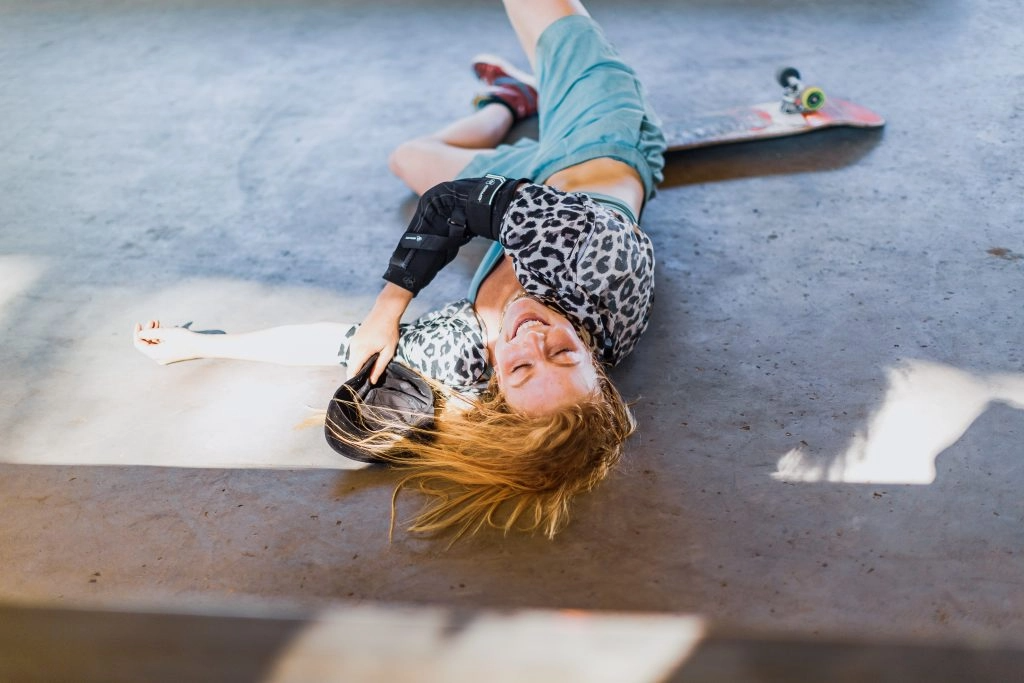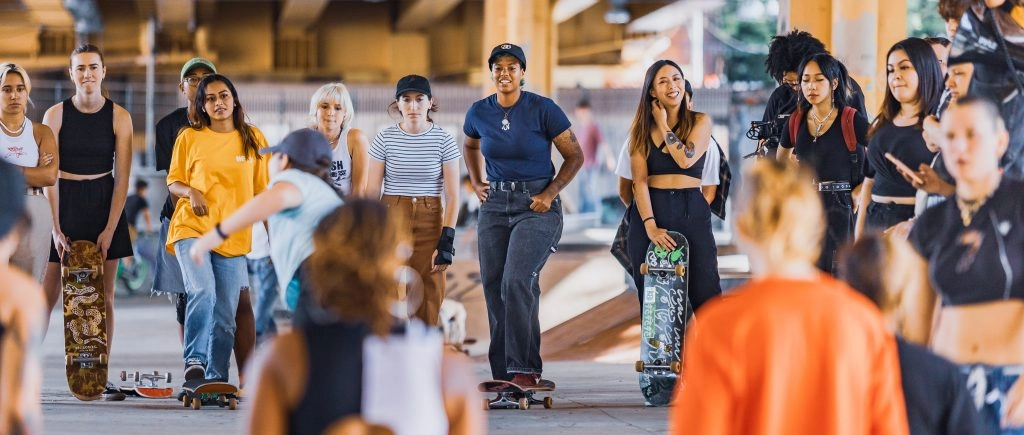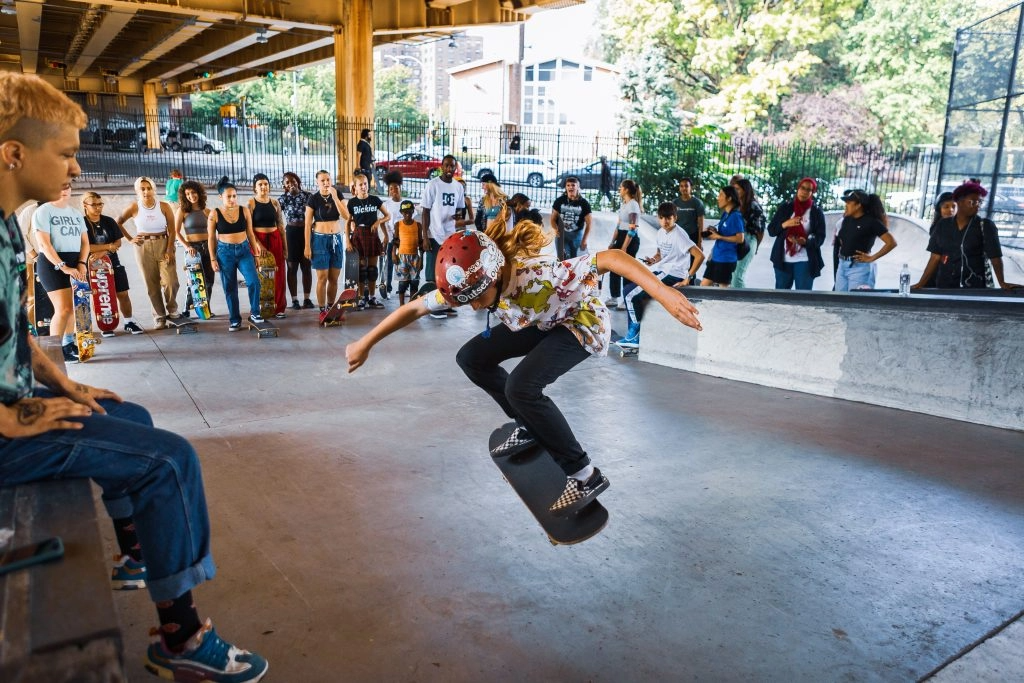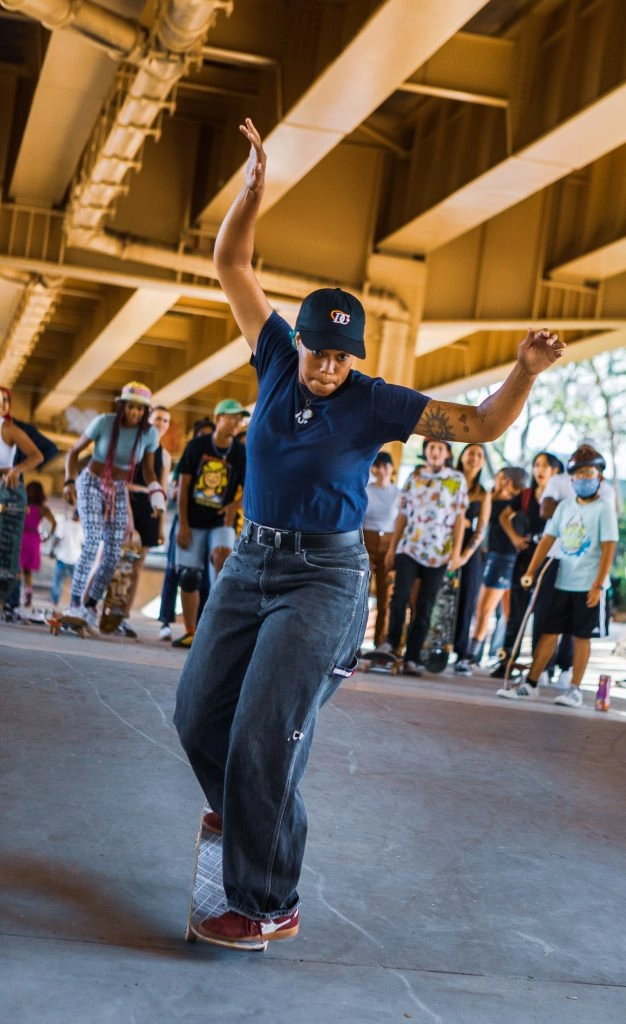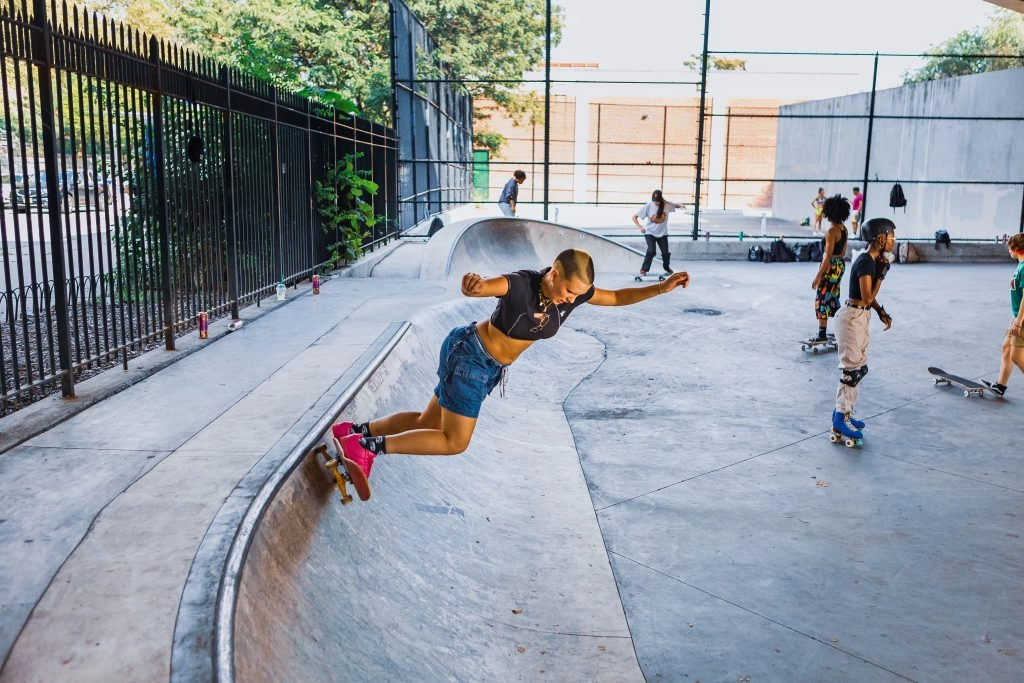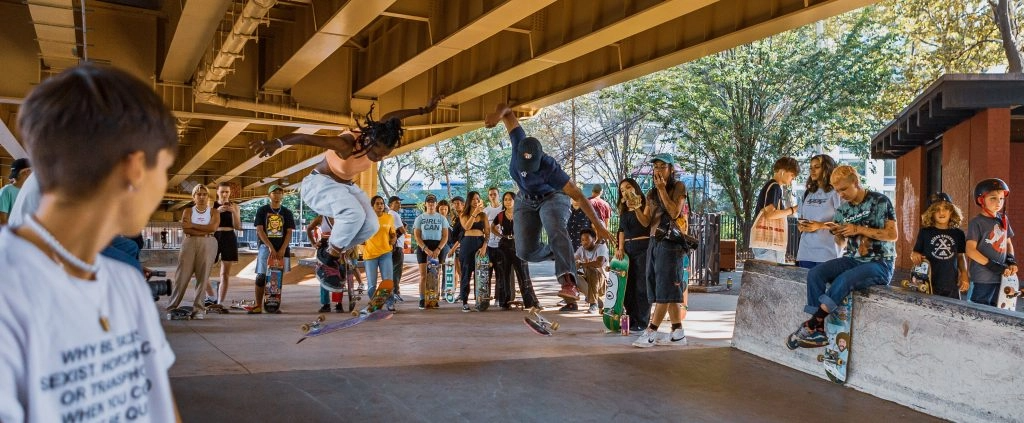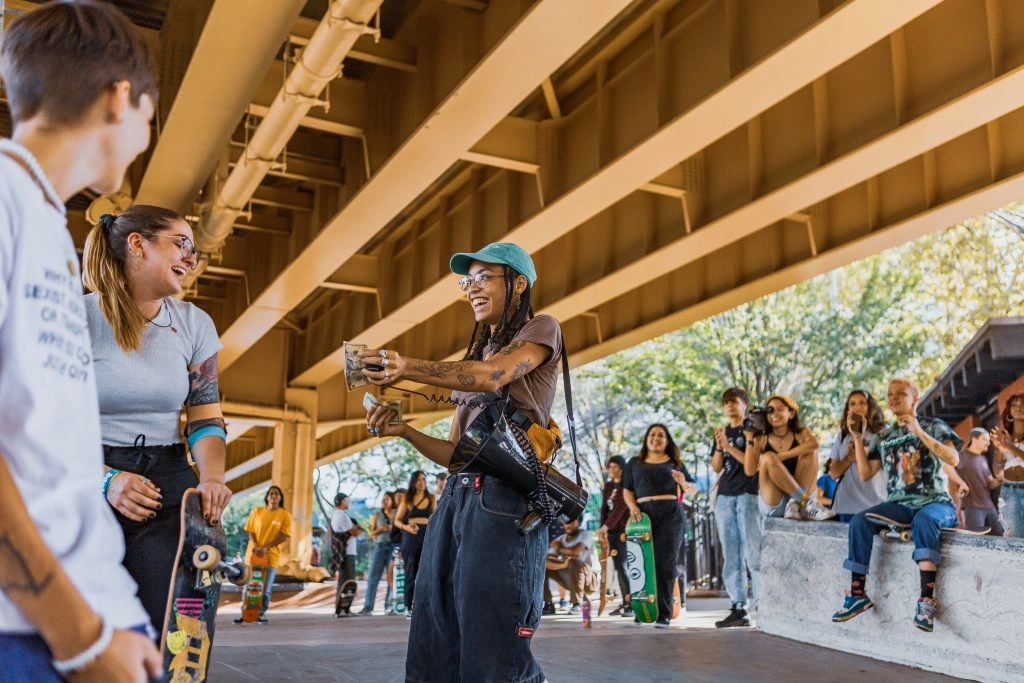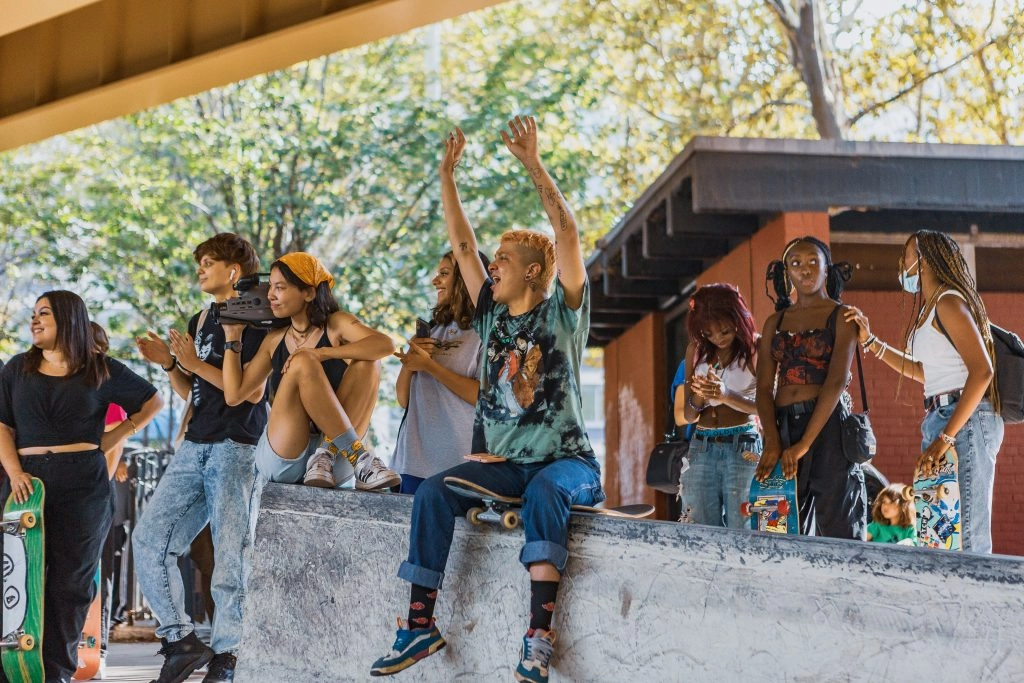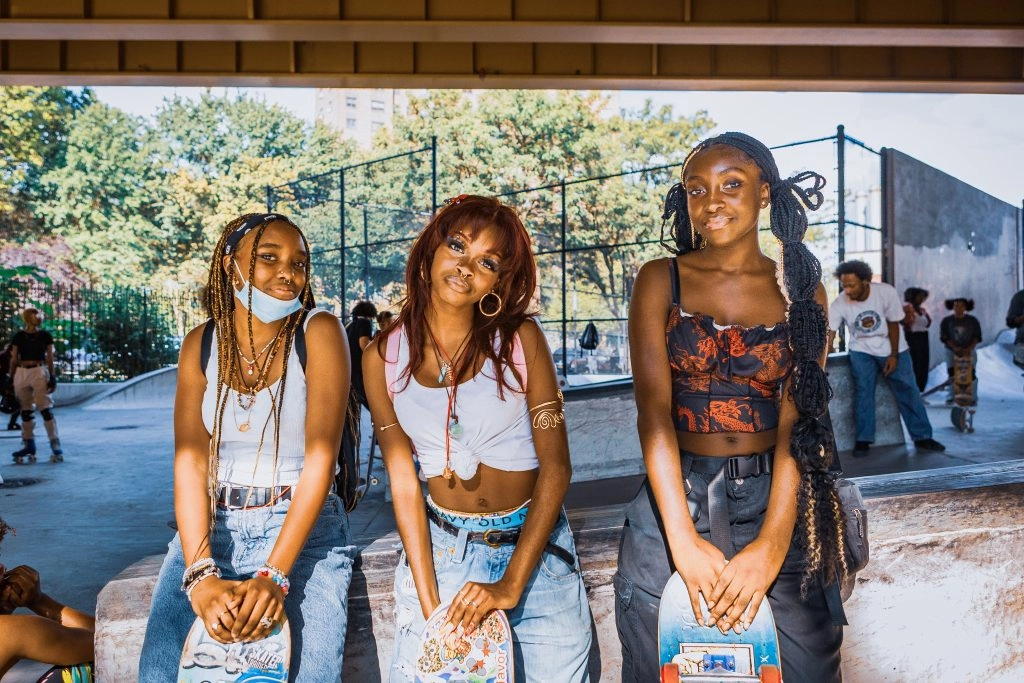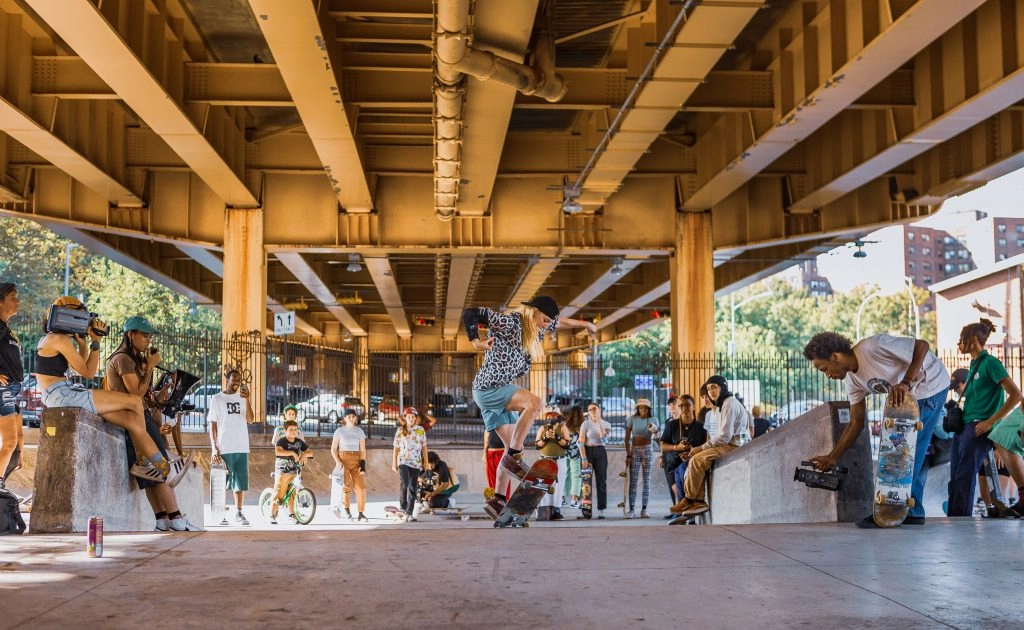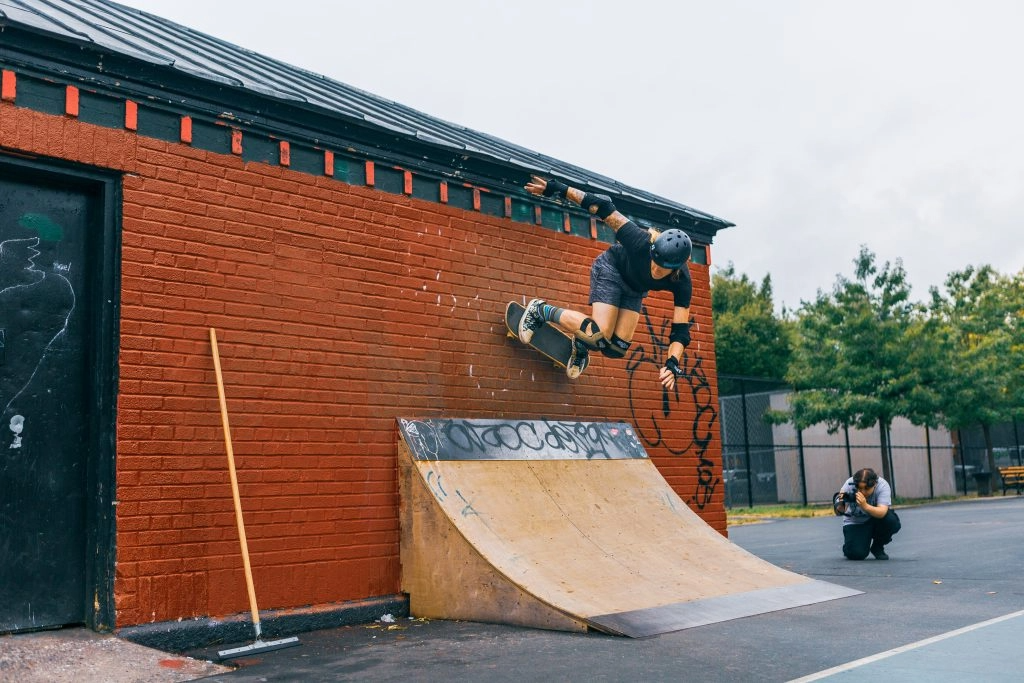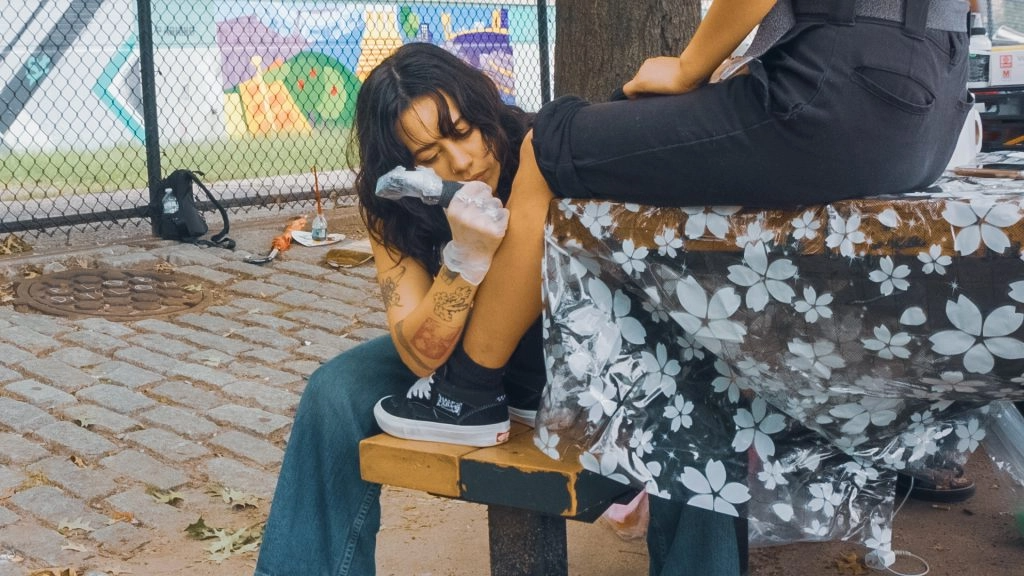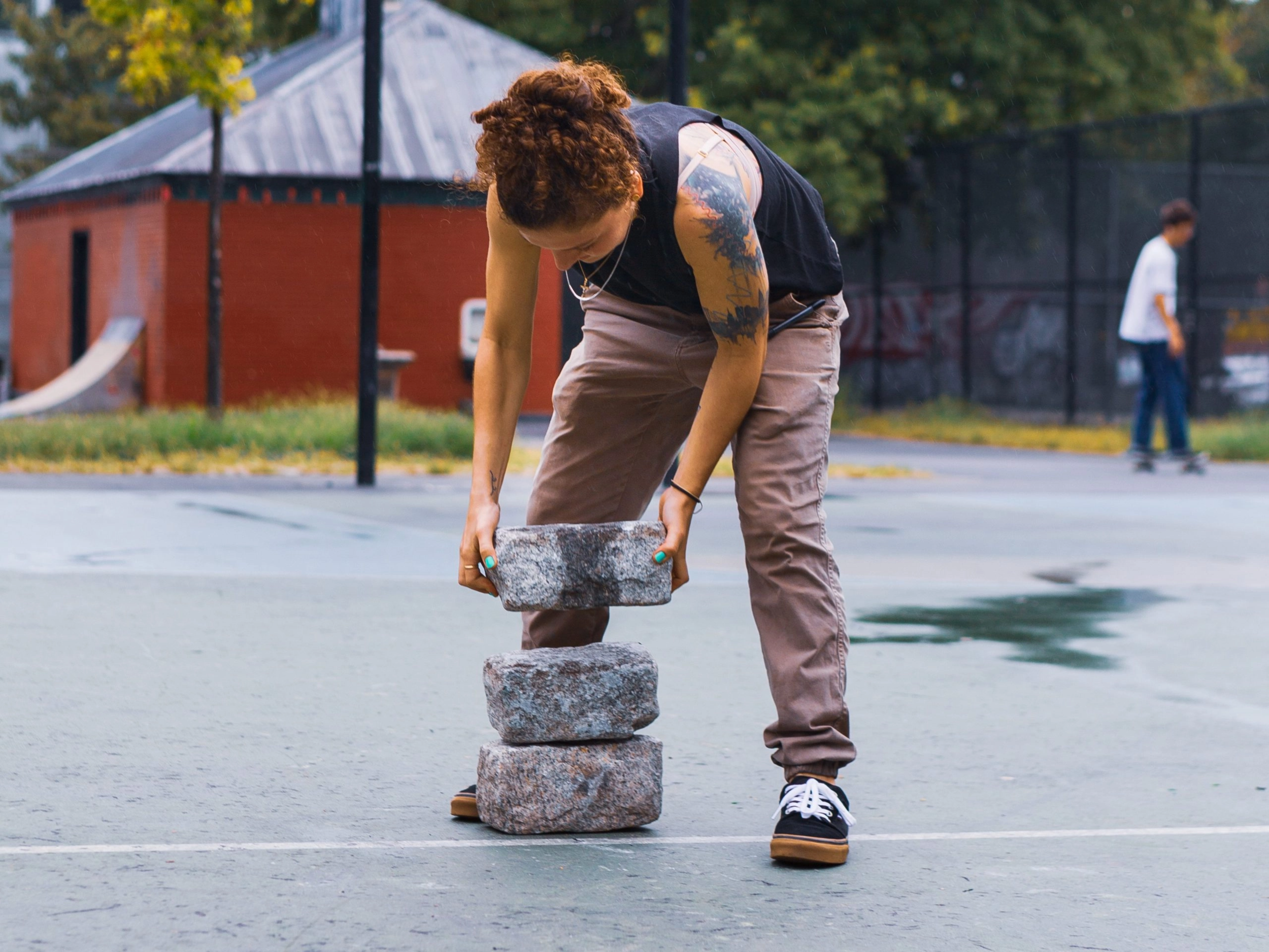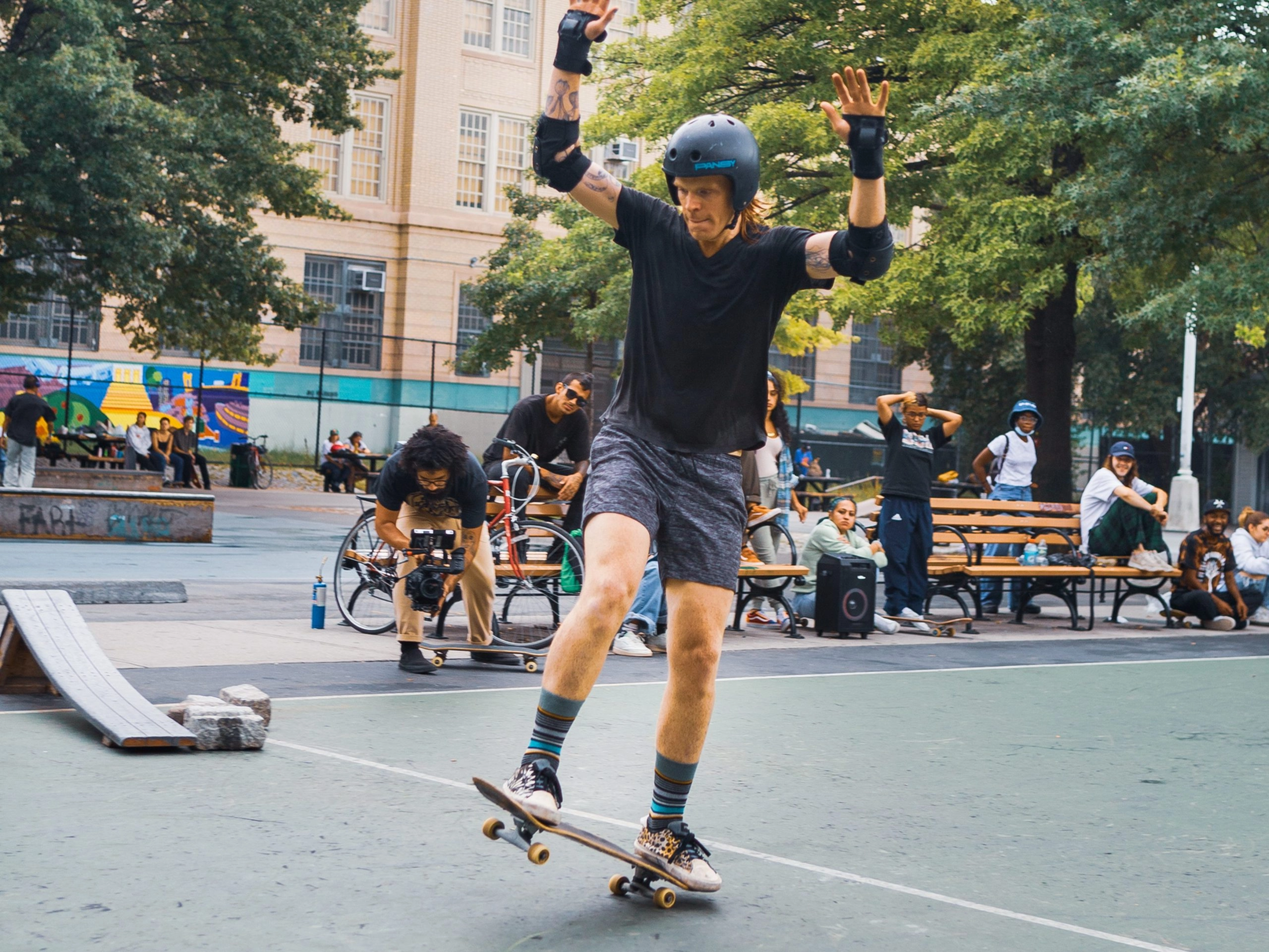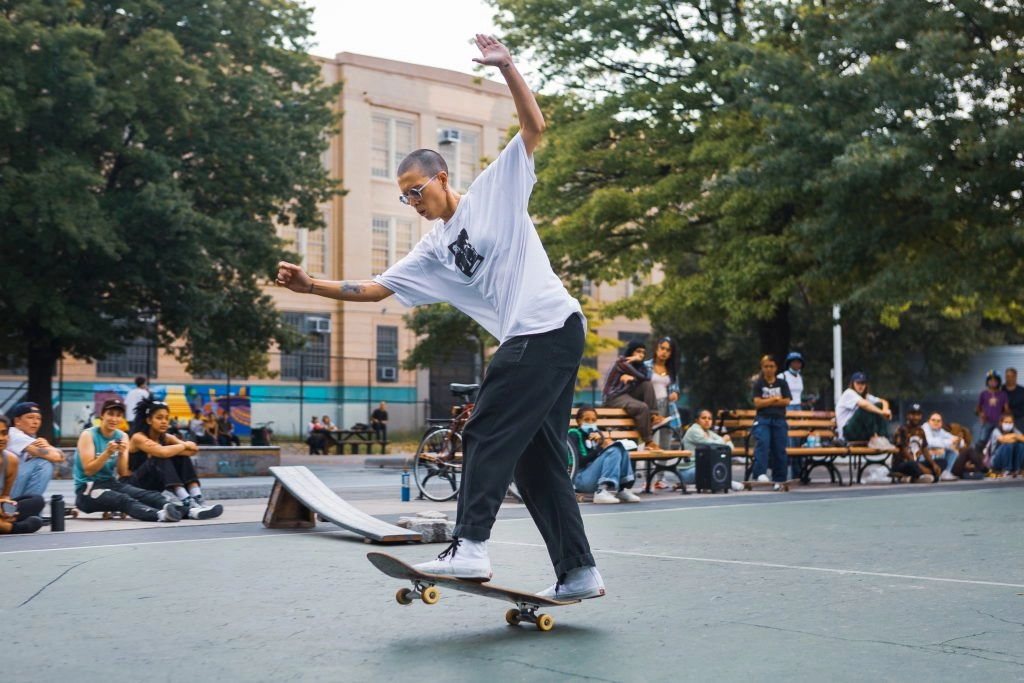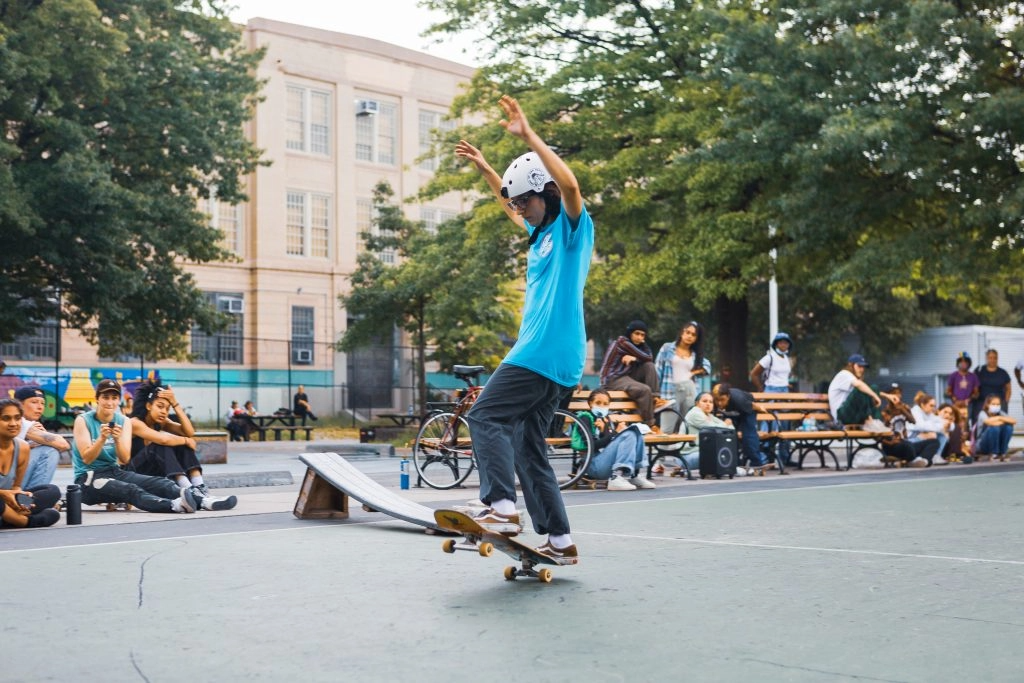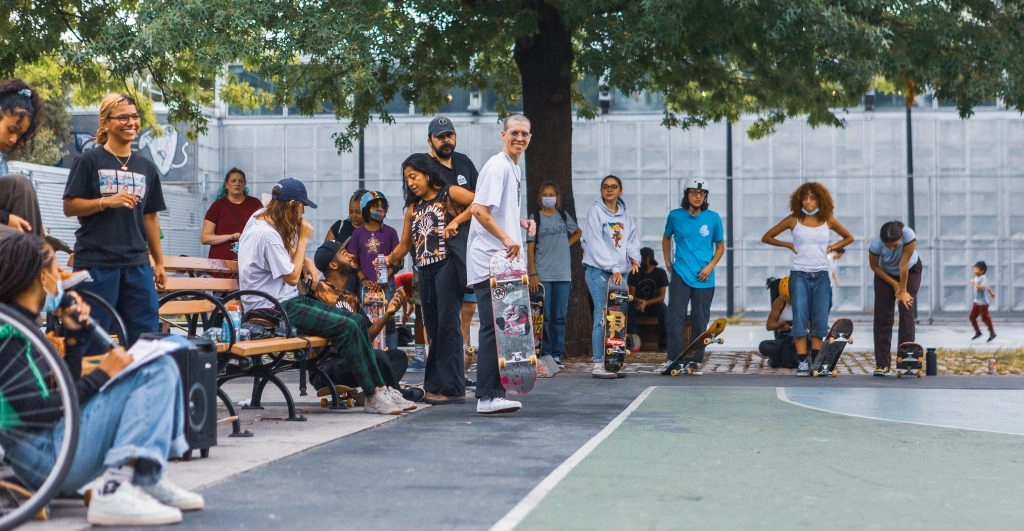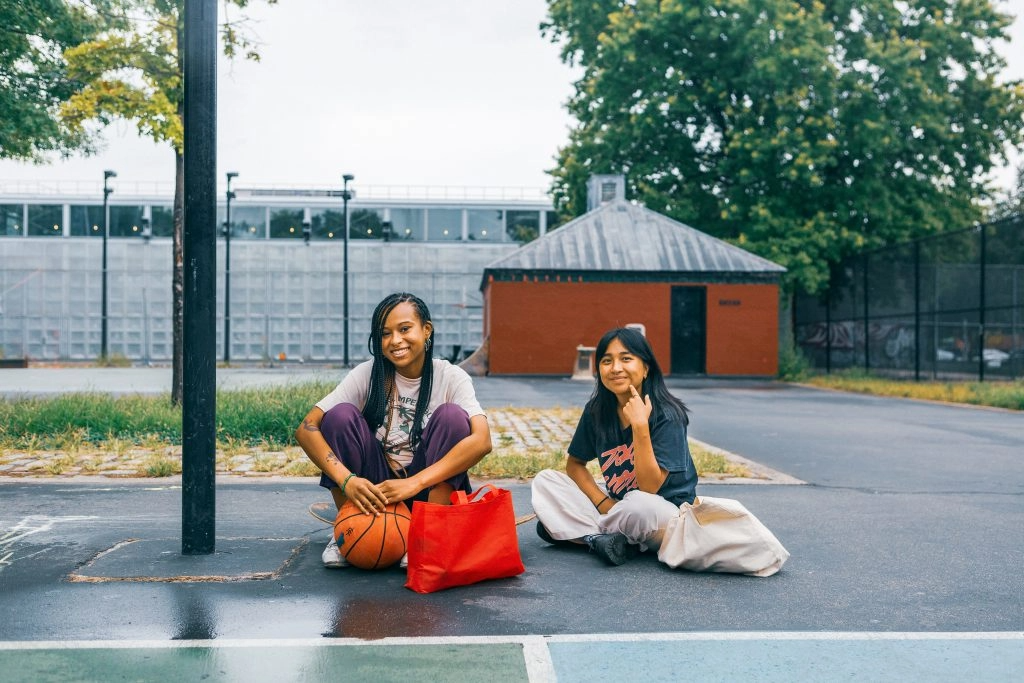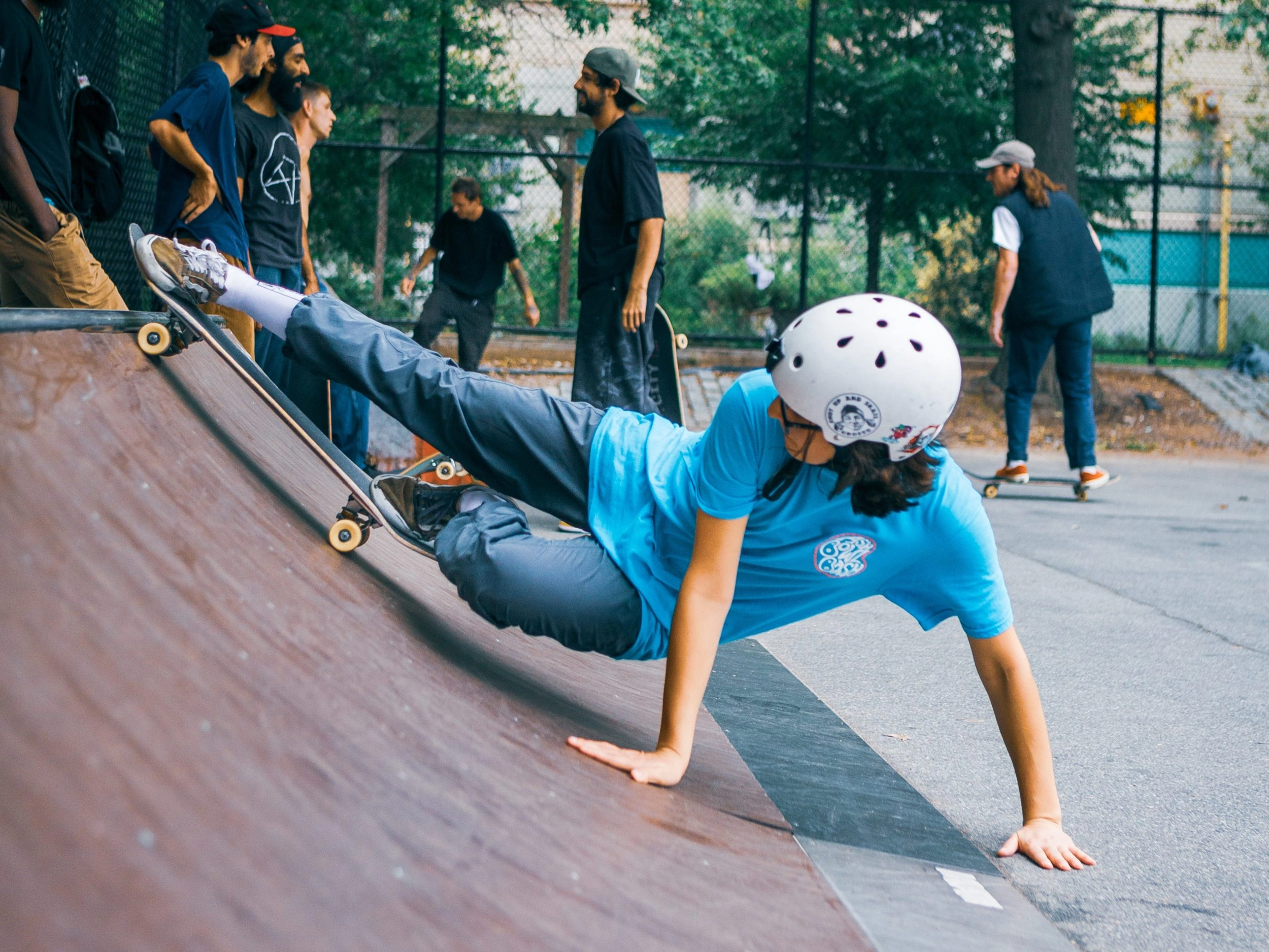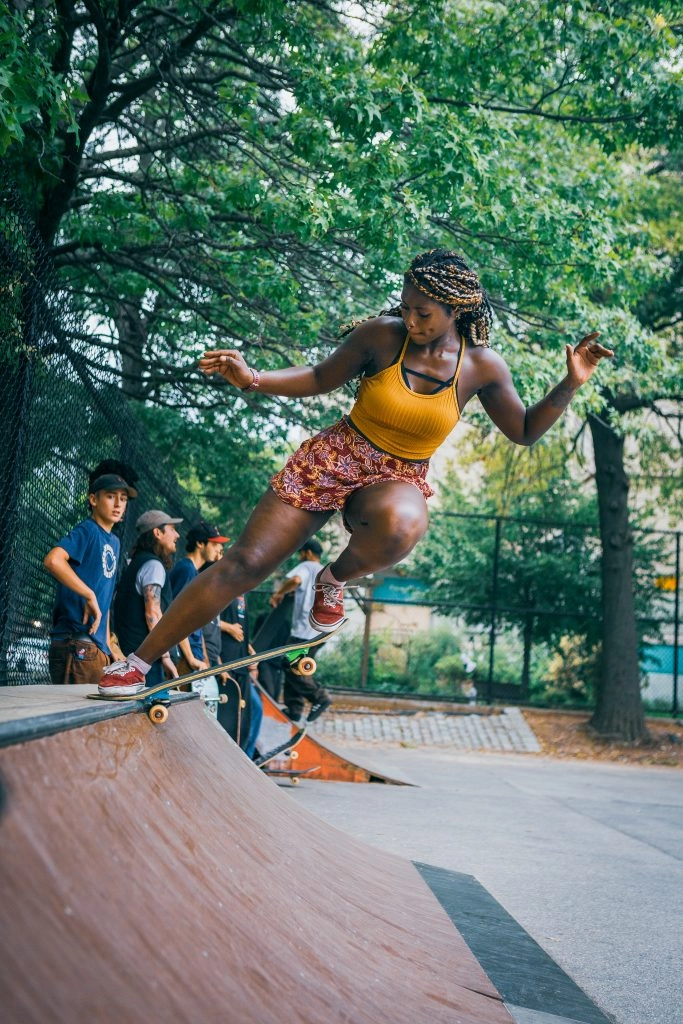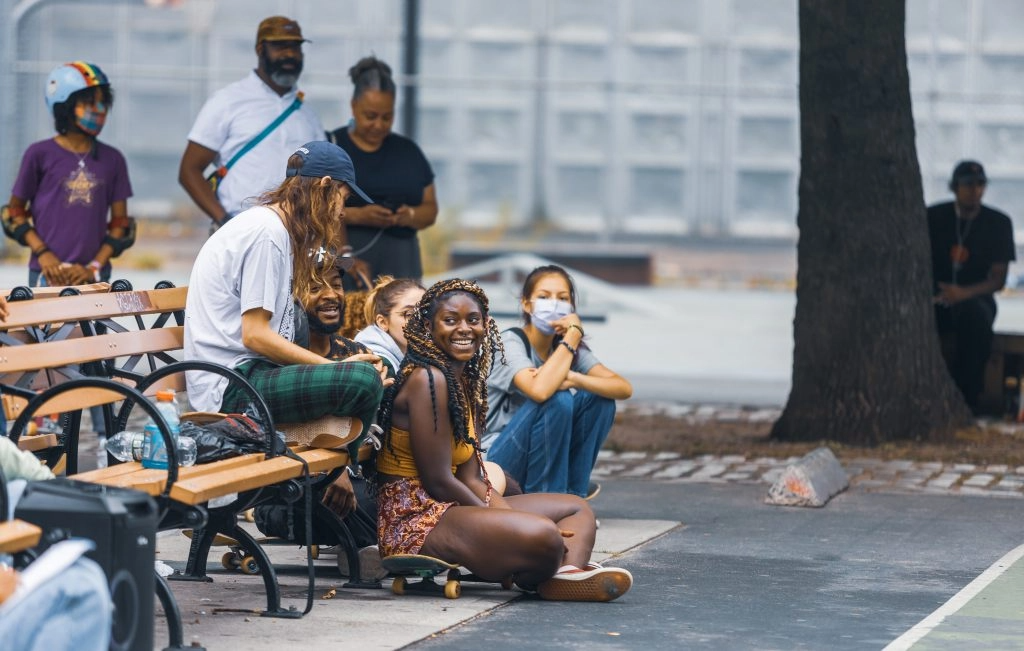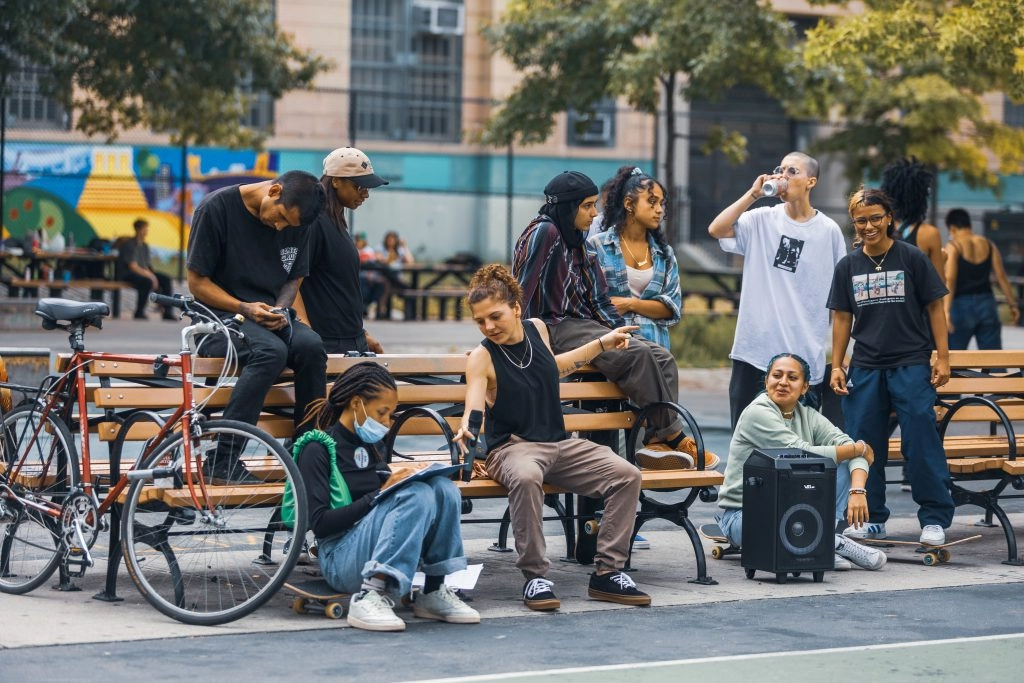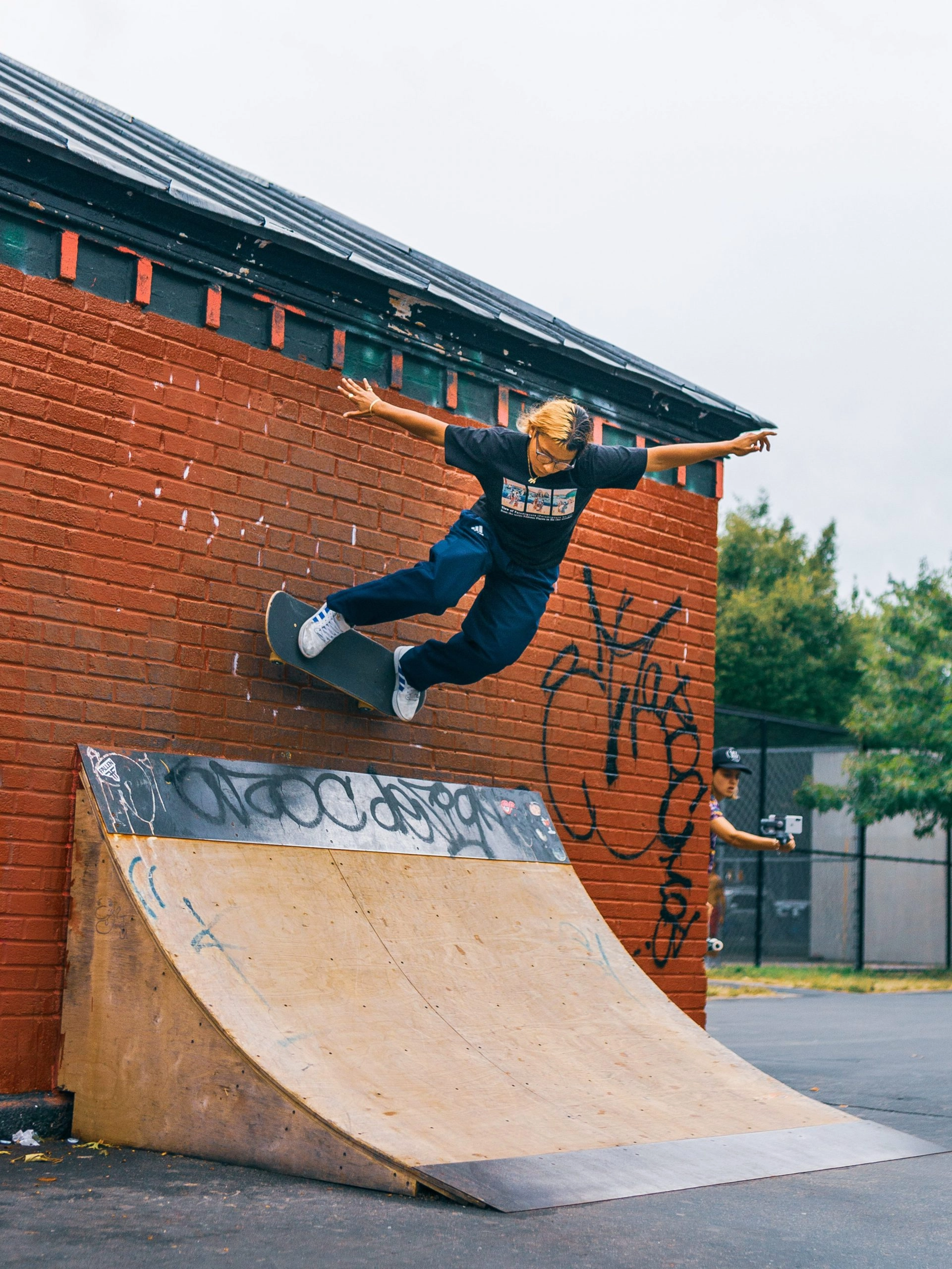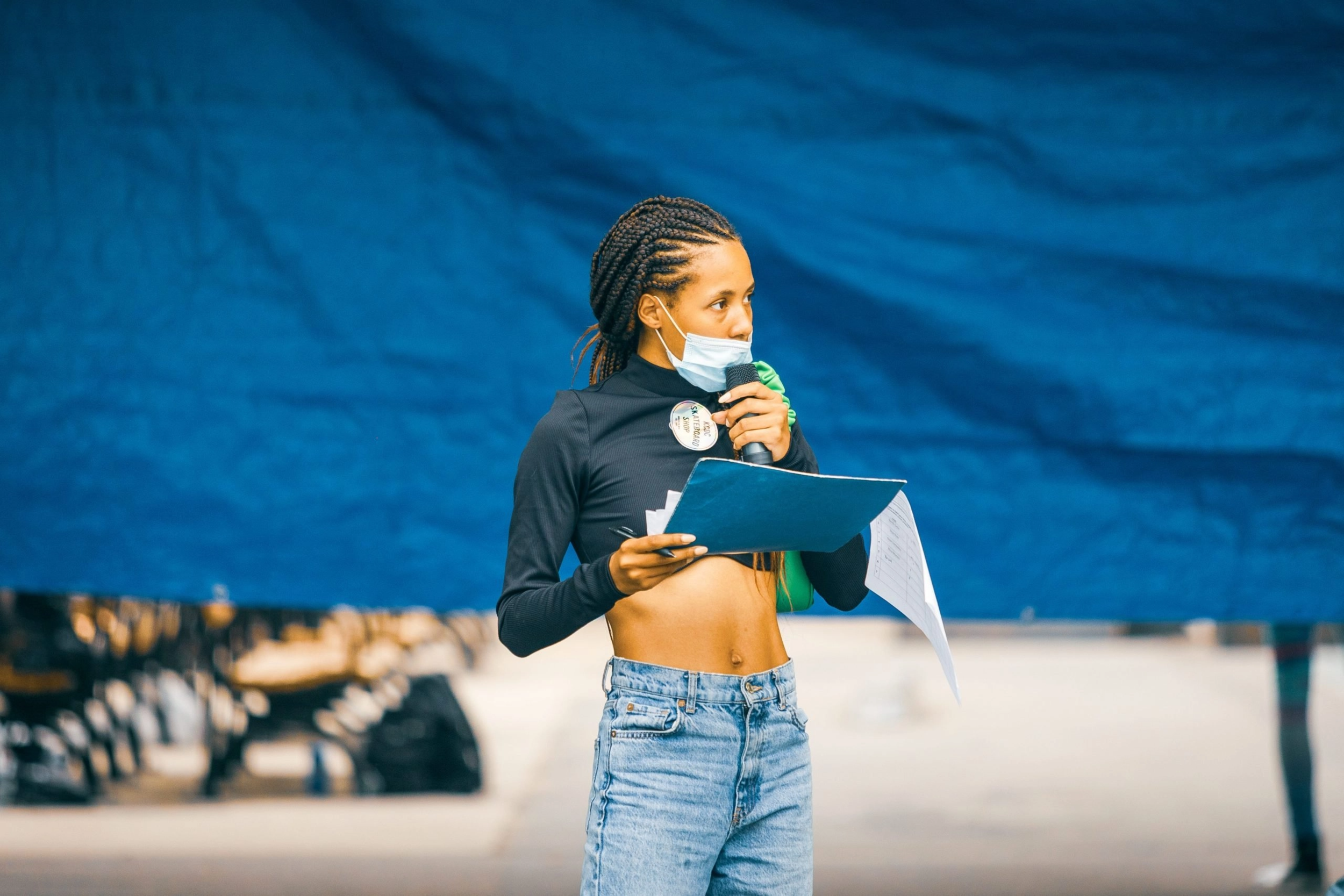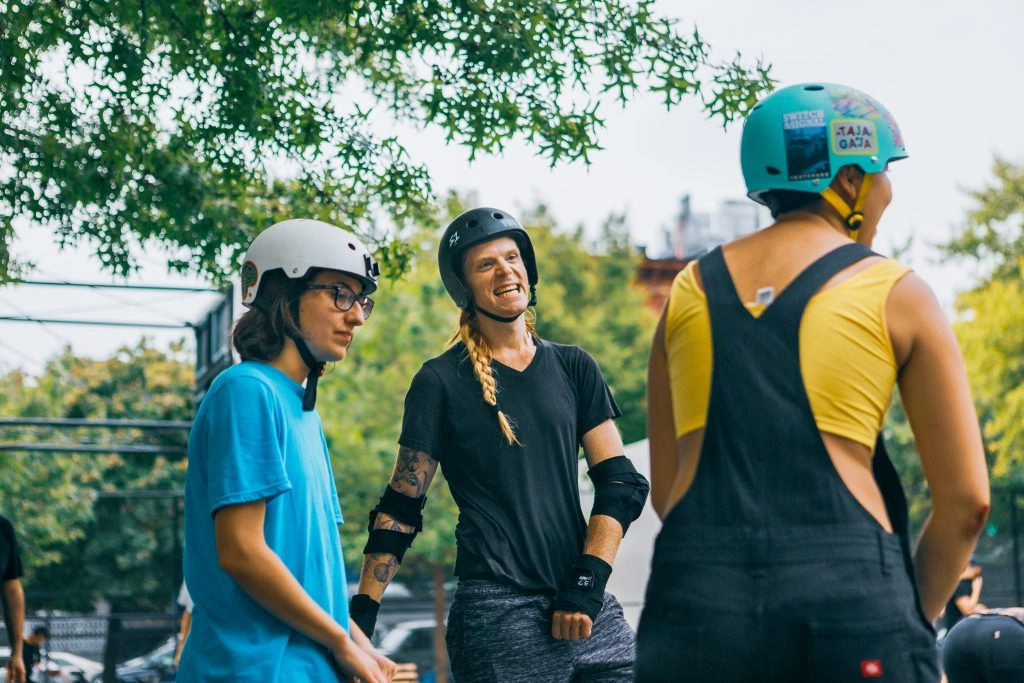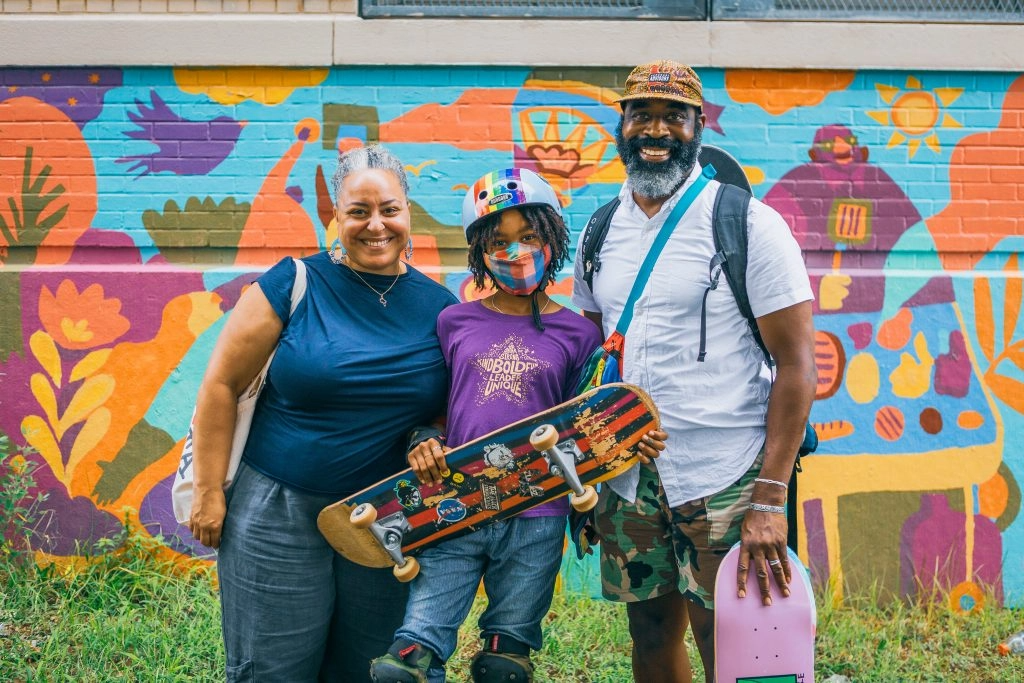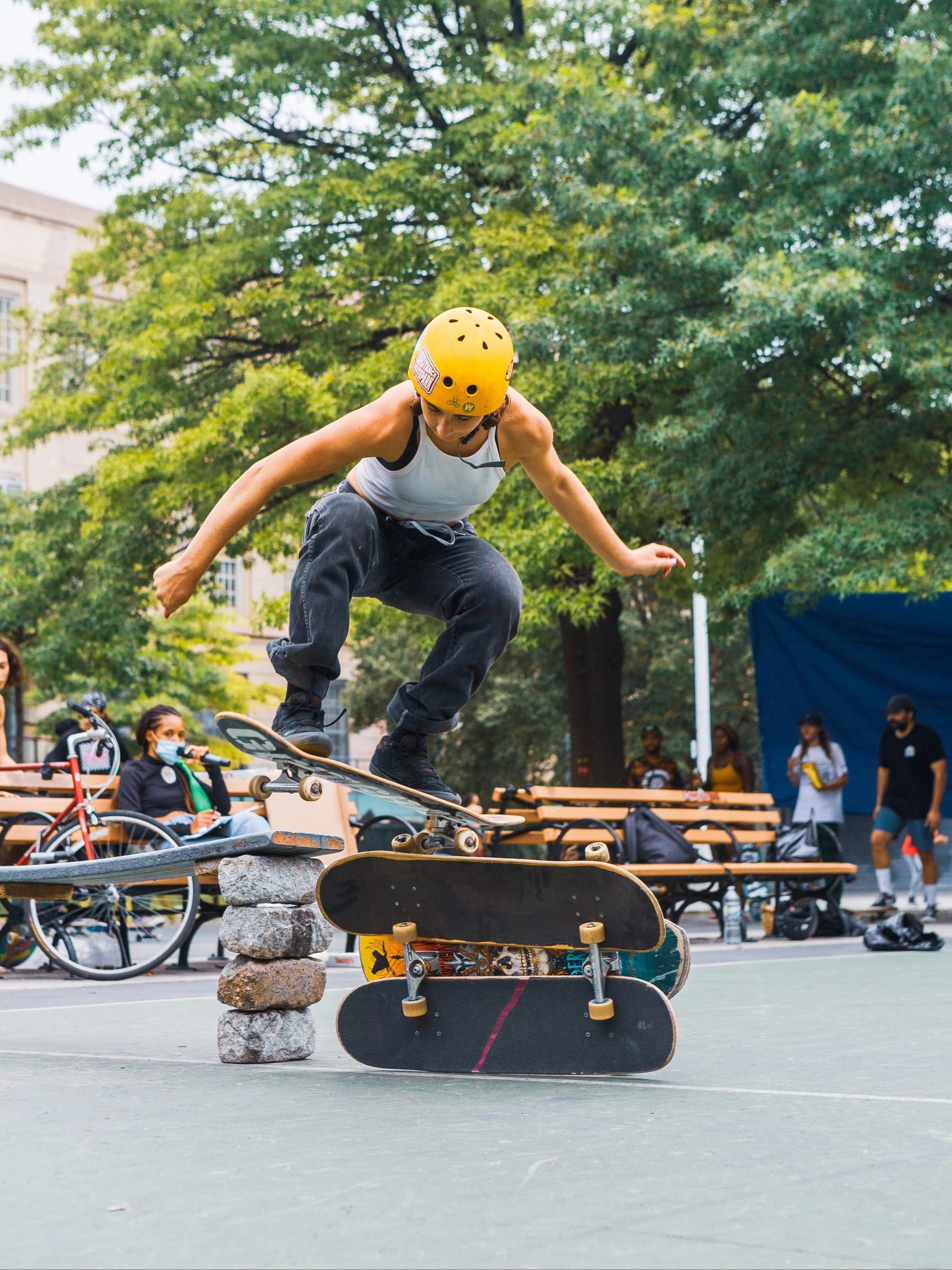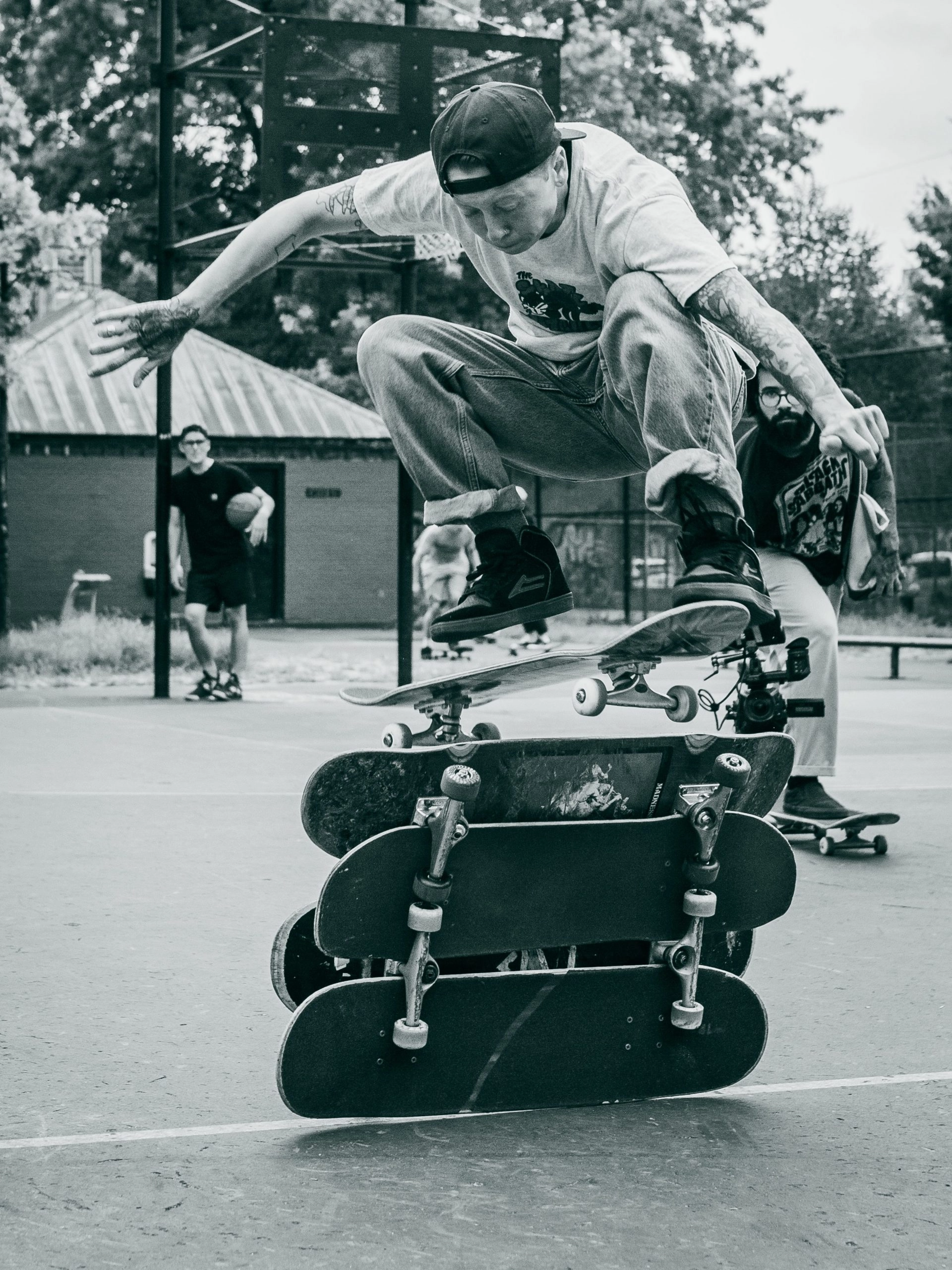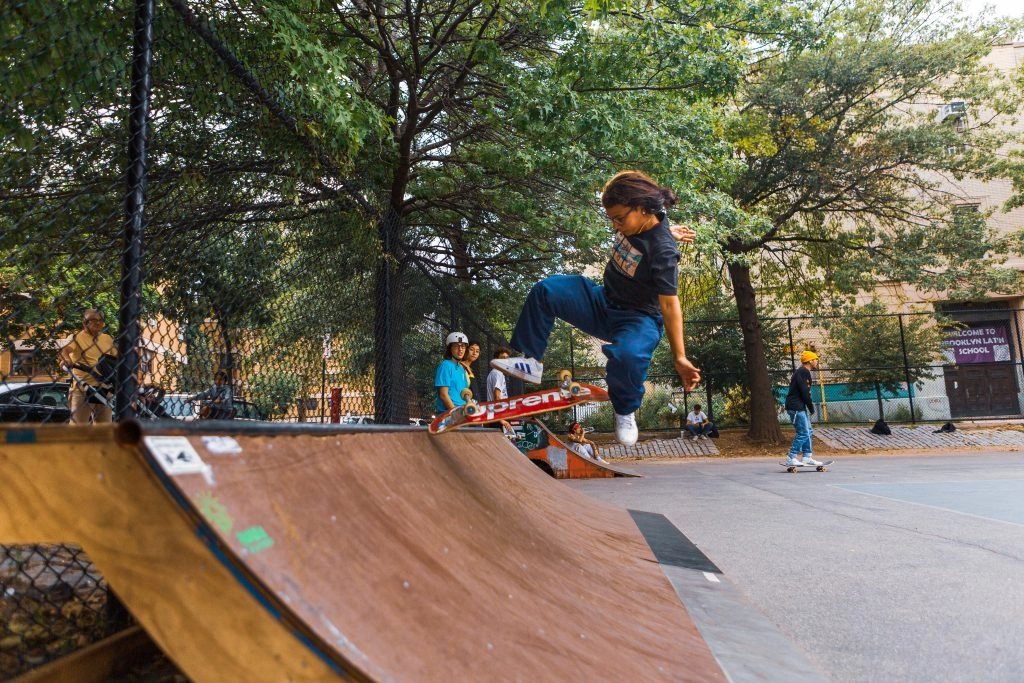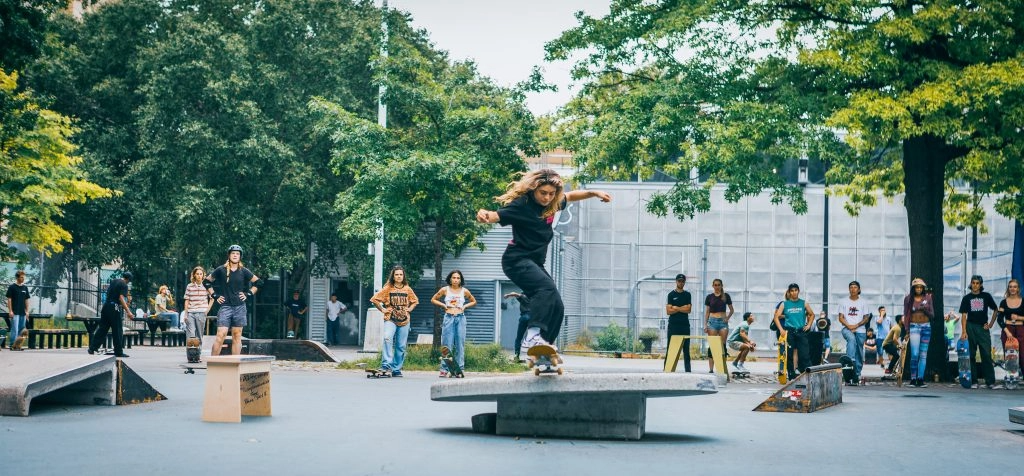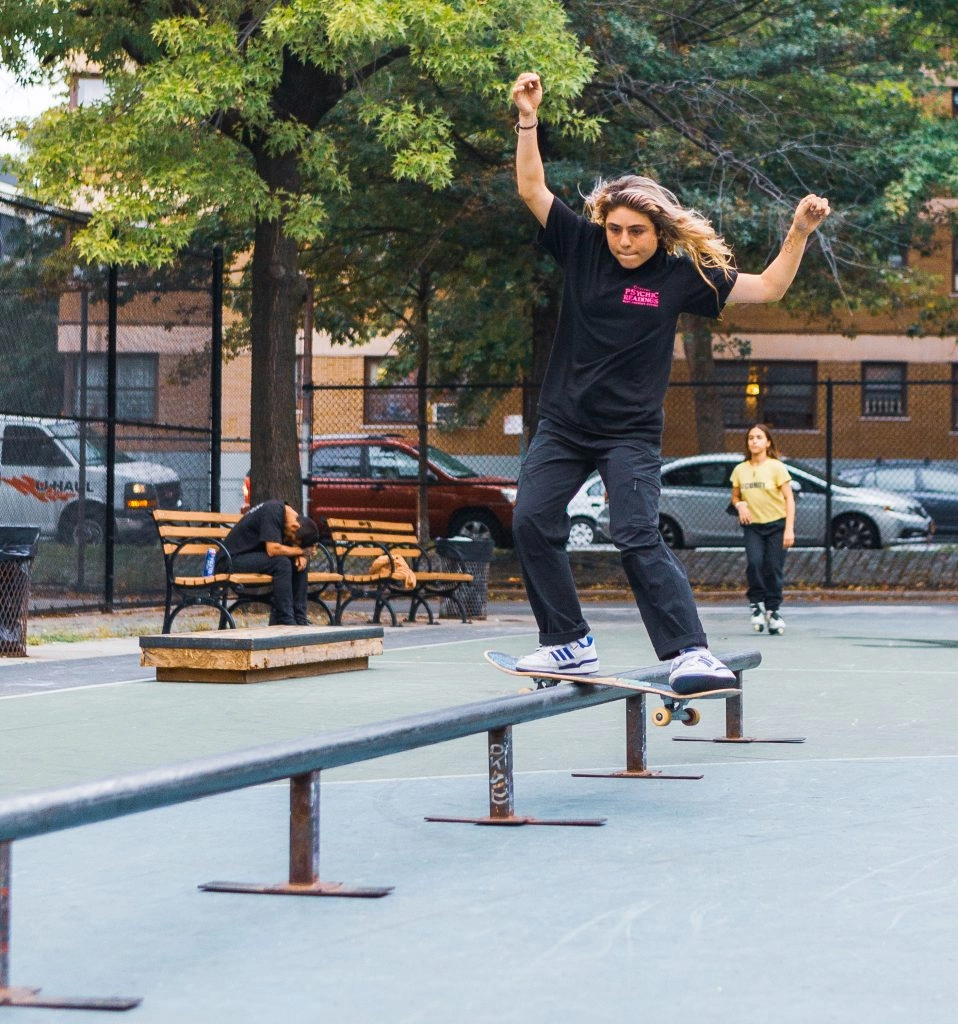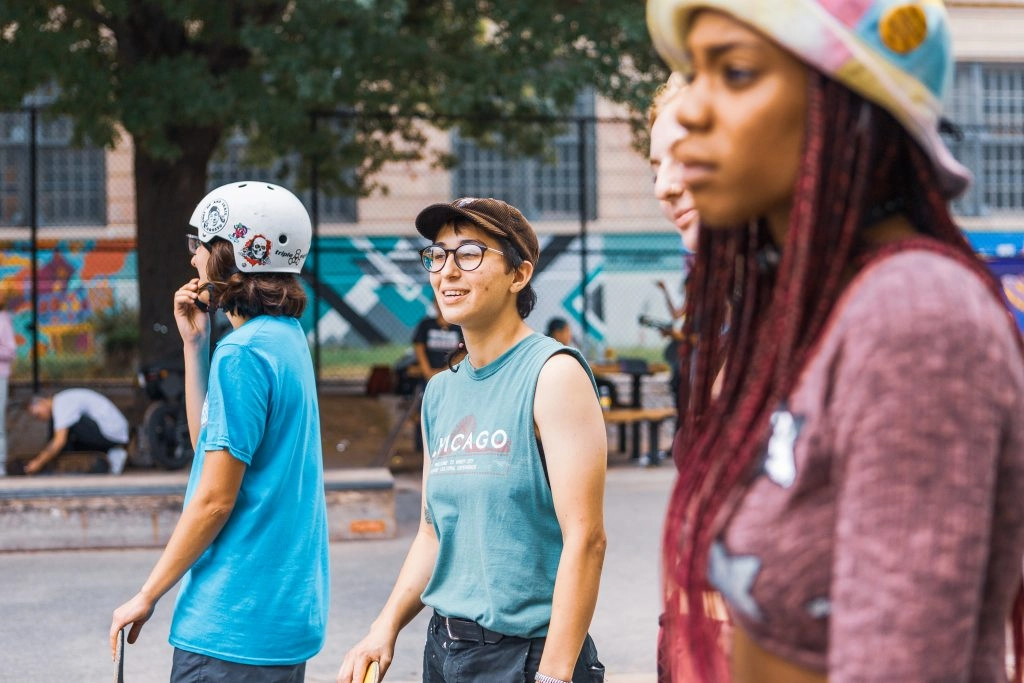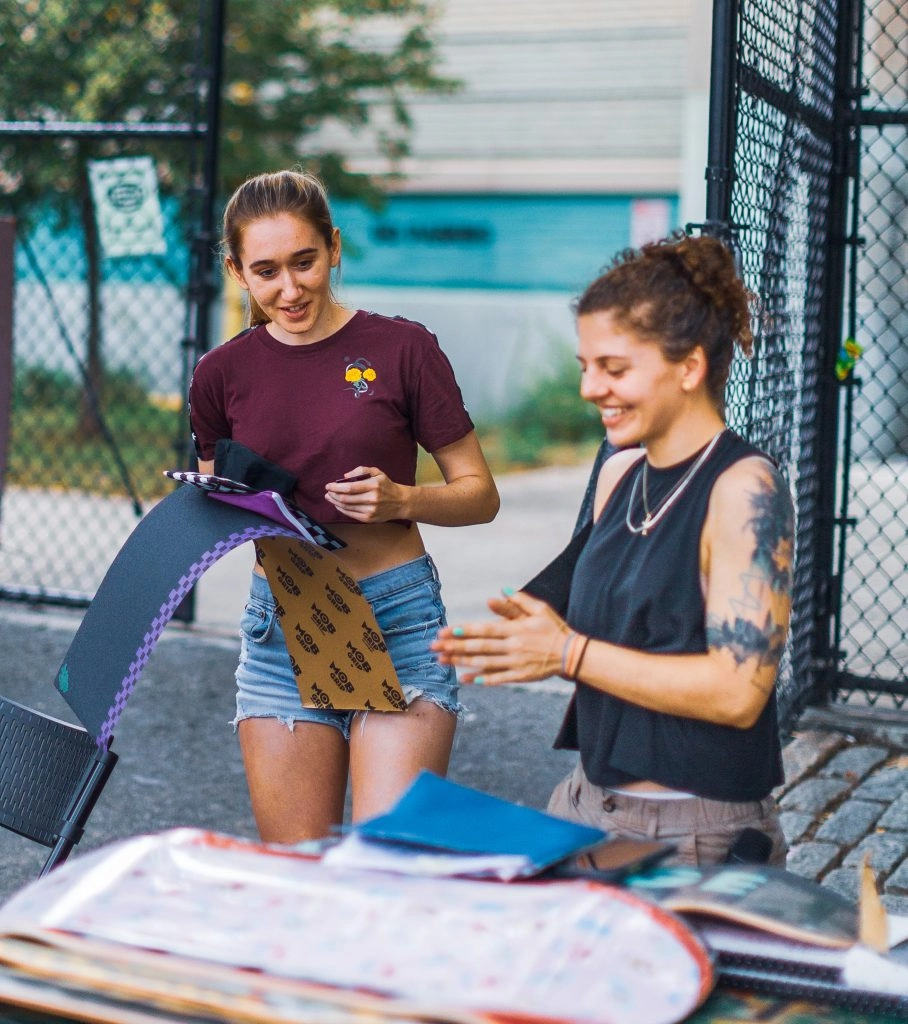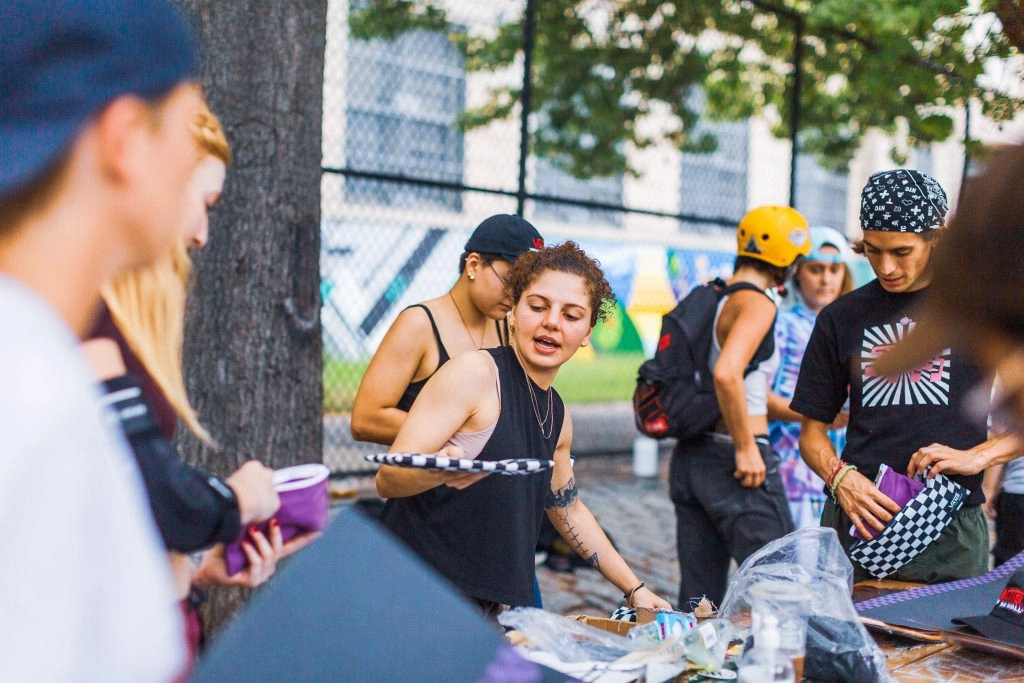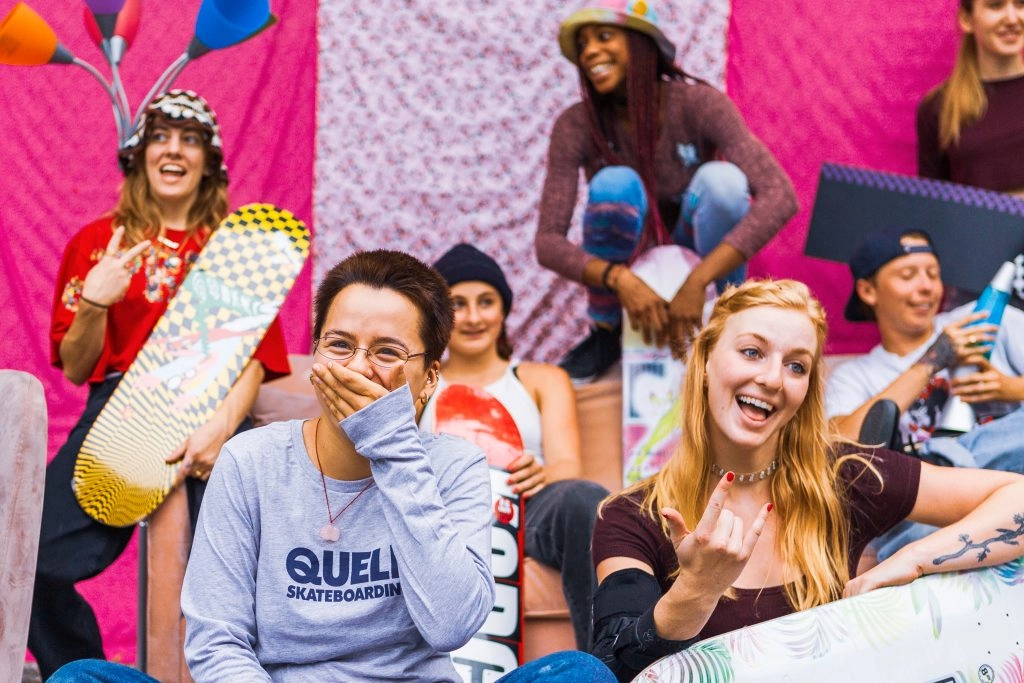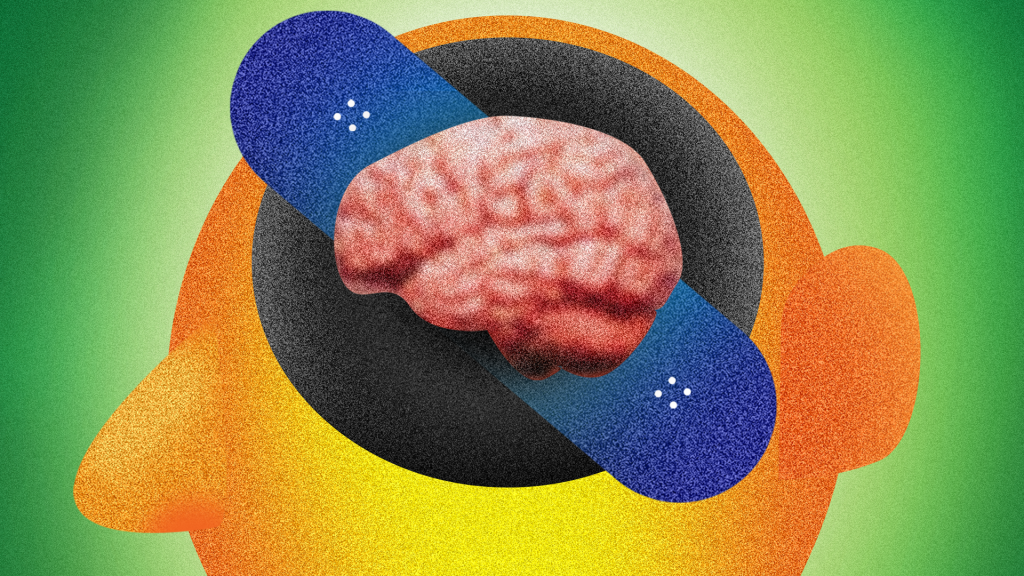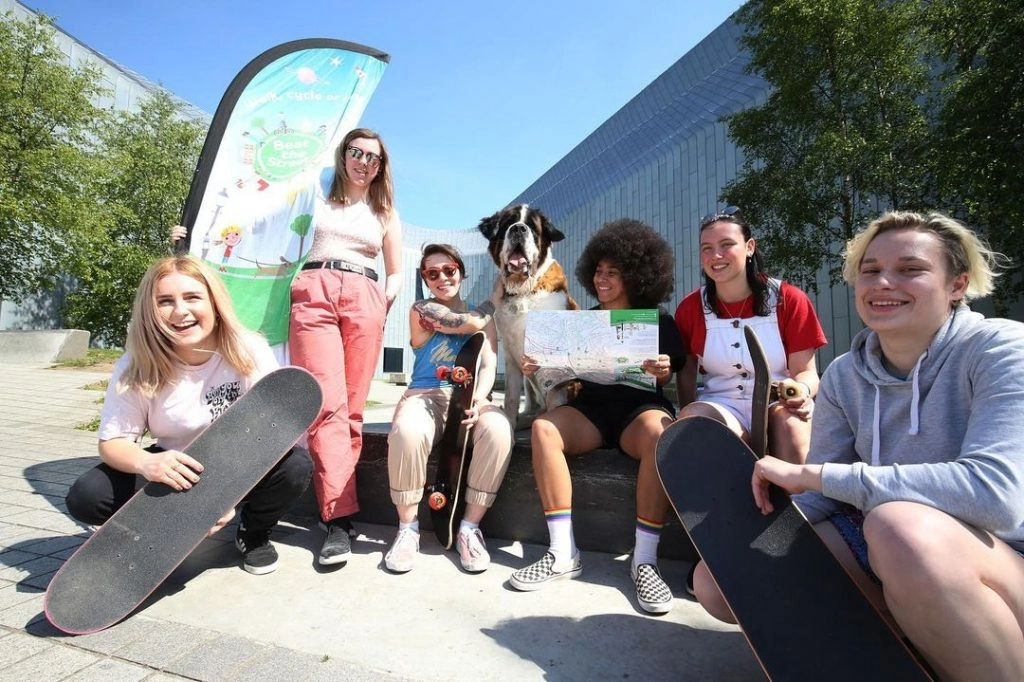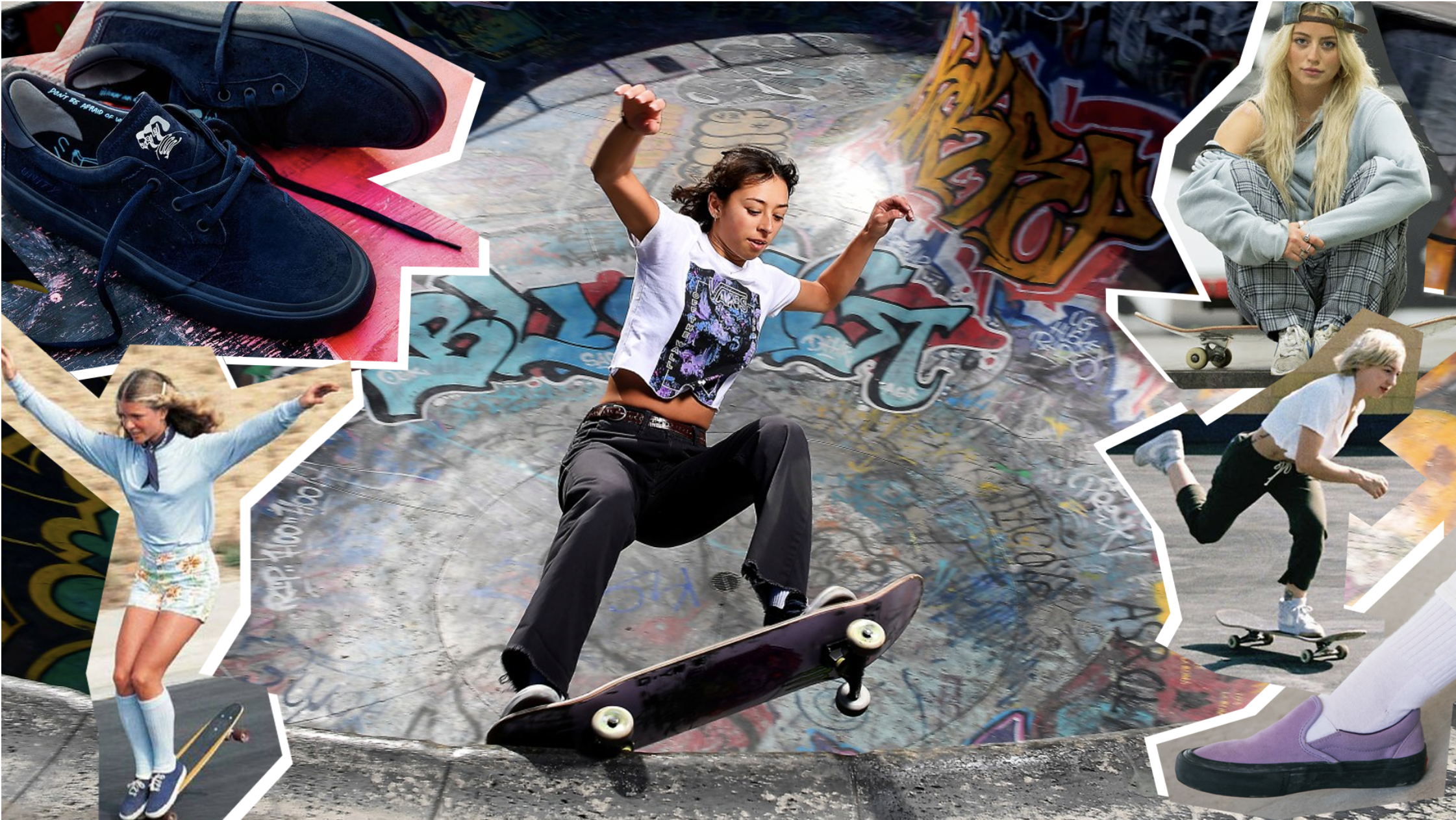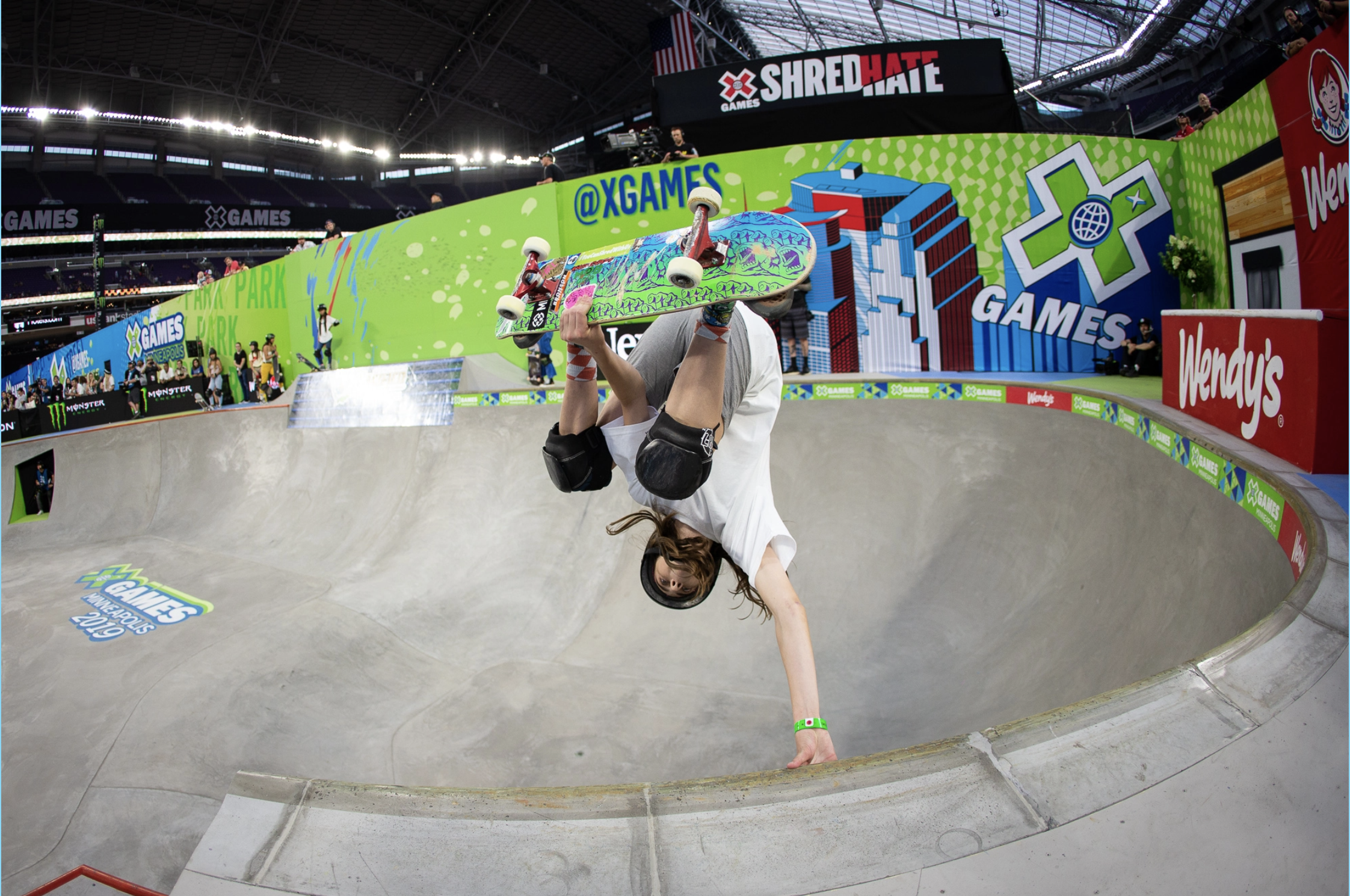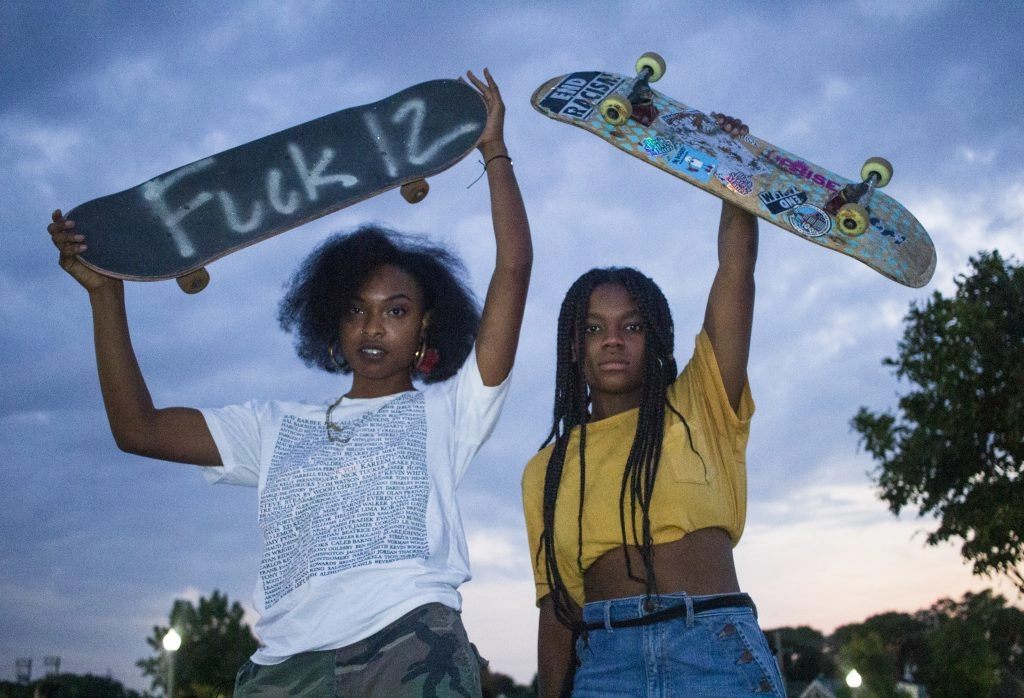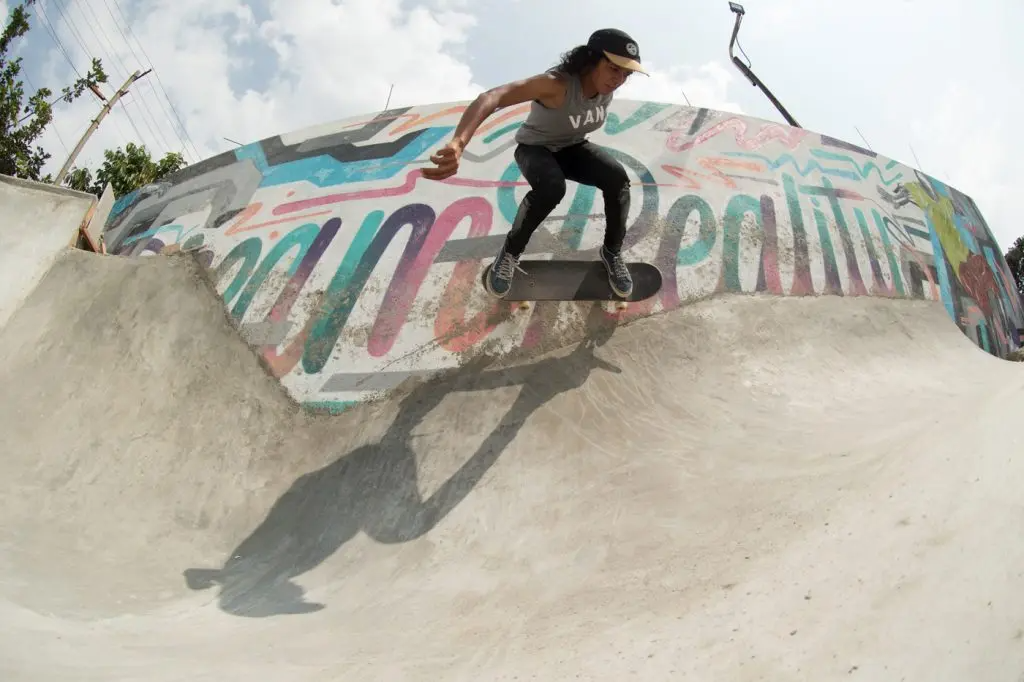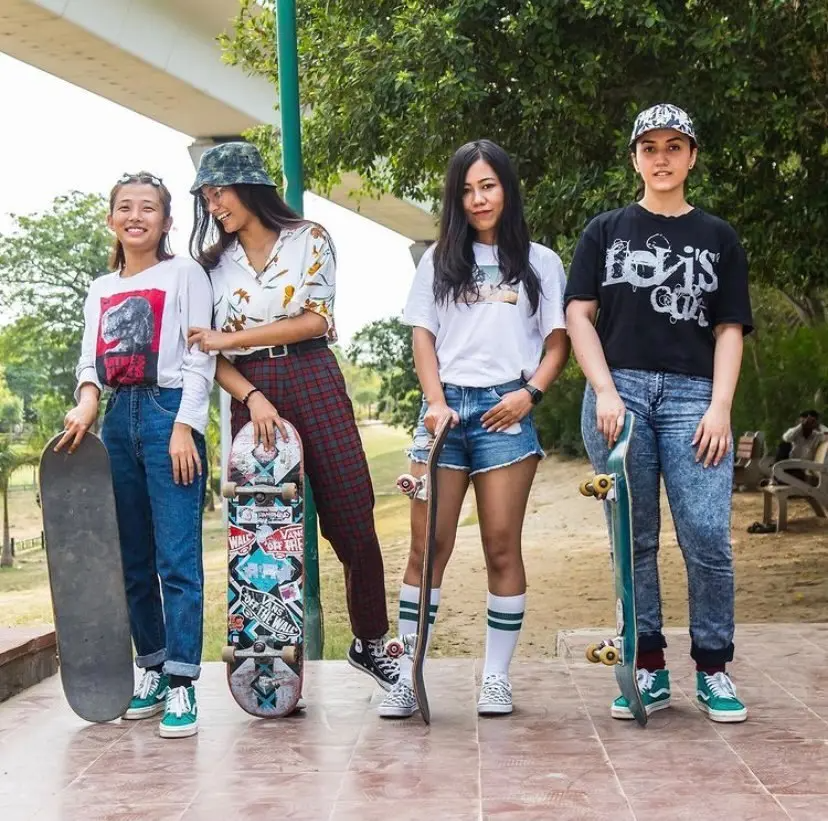On September 11, 2021 almost 100 non-traditional skaters came through to participate in an event hosted by Jae Leanne @e_ninethree, and The Harold Hunter Foundation at Fatkid Skatepark. As part of the Harold Hunter Weekend event, from noon to 5pm all skill levels came together to participate in the clinic, try some tricks for a chance to win cash, and product giveaways. We've always loved the community initiatives by HHF as well as Jae Leanne and what a way to celebrate Harold's legacy and NYC. See photos below
"Having these kinds of inclusive events ... is important because skateboarding is an intimidating sport. I would go to the skatepark as an 8 year old girl and get shoved off ... but when you know there's a sense of community wherever you are it's like, 'hell yeah, let's go and skate ... I just want to have fun'. "
-Alicia Baggieri, participant at Divine Grind.
All kinds of folx braved the risk of rain and arrived together at Blue Park to engage in New York's first all women and non-binary skateboarding competition led and hosted by Mariah Davenport of SPCC Project. Local artists and vendors were welcome to use the space as well during the competition featuring free recycled decks, clothing by Speakeasy Luxe, tattoos by Erin Olivia, and an art installation by Bree Person.
Two sessions were sectioned for beginners and advanced participants overall tallying up to 17 sessions throughout the day. The coveted best run cash prize of $750 was awarded to Mathilda Kosonis for her Switch Blunt, FS Disaster, Feeble, and BS 50-50. Amber Gedman followed up in 2nd place, and Ashley O'Gormam in 3rd.
Accessibility and inclusivity remain paramount within gender and identity, especially in the skateboarding community. We're looking forward to seeing more events like these.
ARTICLE BY NATALIE HARPER
With all the recent conversation in skating around mental health— whether that be with Pushing Borders, Vent City, Quell Party, Skateism, or the ongoing work of the Ben Raemers Foundation— there is a potential now to introduce a new topic to the mix. So far the discussion has centered largely around anxiety, depression, and suicide prevention; however, I believe you cannot talk about mental health without talking about neurodiversity.
Neurodiversity is a term used to describe the natural variations that can exist in human brains. Someone can fit the label of neurodiverse if they are autistic, or have conditions such as dyslexia, ADHD, bipolar disorder, OCD, DID, as well as many others. However, it is entirely up to the person whether they choose to use this label or not.
As a disclaimer before we begin, this will not be comprehensive for all neurodivergent people, or even those who share my neurotype. What is to come was not created out of expertise, but out of necessity. Neurodivergent people are already very much a part of this community and yet there is little to no discussion of our existence, much less our needs, in skateboarding.
If there was more awareness of this and the lives of neurodivergent people then we as a community could spend less time managing symptoms and more time addressing possible causes and triggers.
I am an autistic trans woman with ADHD and OSDD 1a. I also have an anxiety disorder and experience depressive episodes. Oftentimes, as was the case for me, what may look like anxiety or depression at first is just a small piece of something more complex.
While changing a society will take time, the skate community can take a more active role in this change by making our spaces more welcoming for neurodivergent people.
SAY WHOSE TURN IT IS IN A RUN/LINEUP.
There is a great deal of nonverbal language that occurs at a skate spot. If someone is a newcomer, regardless of neurotype, they may not understand all the eye contact, head nods, and pointing that goes into figuring out who’s turn it is to skate an obstacle.
Many autistic people, myself included, have difficulty processing body language and facial cues, so the message you are trying to send with eye contact and a head nod might go right by us. Instead, try communicating verbally (and politely) whose turn it is.
PLEASE TURN DOWN THE MUSIC.
What may seem like a normal volume to neurotypical people can go from distracting to debilitating for autistic people and others with a sensitivity to sound. One solution to this would be, as has been done already at many movie theatres and restaurants, to set aside time when the music will be set (or capped) at a lower volume, or to simply turn it down the whole time.
“One thing I have done at skate events in the past is create a "quiet room," quiet being relative... but we set aside our back room for anyone who needs to step away from the bright lights and loud noises of the skatepark,” says AJ Waters, founder/owner of Stronger Skatepark.
“We set it up with some bean bag chairs, and bottles of water back there for anyone who needs them. Skateboarding is a very loud sport and it's really hard to minimize the sound, so having headphones and ear plugs available is a nice option as well.”
DO NOT STARE AT PEOPLE WHEN THEY STIM.
Short for self-stimulatory behavior, a stim is any repetitive movement used by an autistic person to either calm themselves down, build up focus or energy for a particular task, or express a strong emotion such as excitement or distress. This can include things flapping hands, rocking back and forth, leg bouncing, or hair twirling.
Many autistic people attempt to “mask,” or hide, their autsitic traits in order to blend in better with neurotypical society. I regularly limit my stims when I am out in public to what I feel will go unnoticed by most neurotypical people.
Masking can have an adverse effect on the person’s mental health, especially when it comes to stimming. Not doing so when we need to can lead to dysregulation and a build up of stress in the body. Autistic people need to know that in any space, whether that be at the store or the skatepark, we can stim without fear of getting odd looks from strangers in order to function at our best and truly be ourselves.
BE MINDFUL.
“I think the biggest thing I would want skaters to be aware of is the way they are taking up space. So many people at the skatepark skate super aggressively, and honestly most of the time skating that way is fine, but the way they stand on the deck, the way they jump at every opening to take a run, the way they yell when they are upset, etc... all these behaviors make the skatepark a super unwelcoming place to all sorts of people including neurodiverse people, who are more likely to experience anxiety,” AJ informs.
“So many skaters (especially men who have been skating a long time) just have no idea how their behavior, body language, skating style, etc. affect everyone around them.” AJ makes an excellent point that “by making skateparks more inclusive to beginners, queer people, women, etc, we are also making the skatepark more welcoming to neurodiverse folks.” Some of the work has already begun but these more established practices can be expanded slightly to help make skate spaces more welcoming for neurodivergent people.
BE INTENTIONAL WITH YOUR LANGUAGE
I often see posts for skate meetups that say something like “all abilities welcome.” However, for a long time this phrasing confused me. I couldn’t figure out if it means “all ability levels welcome,” as I have also seen it written, or if it is meant to imply that you are welcome whether you are able bodied or disabled.
If it is meant to also passively imply that disabled people are welcome, then why not instead take a more active approach and change it to something like “All Abilities and Disabilities Welcome”?
Of course, when inviting disabled people to an event or space, it is important that their accommodations be met. It is my hope that this article can be a small piece in that larger conversation that includes the work already being done in adaptive skateboarding and the wider disability rights movement within our community.
On the reverse side, be aware of harmful language being used by others. “There is also still a lot of homophobia and transphobia in the skate community, and there is a huge overlap between neurodiverse people and queer people.” says AJ, “So going to a skatepark and hearing gay used an insult can make many neurodiverse folks feel unsafe.”
NAME AND PRONOUN CIRCLES.
This small activity that is being used more frequently in skating can go a long way in helping a community that has long been stigmatized by society. People who have dissociative identity disorder (formally known as multiple personality disorder), OSDD 1a, or OSDD 1b may have one or two alters that enjoy skating.
It can help people with these disorders be their authentic selves and feel comfortable even entering a space if they are simply asked in the beginning their name and pronouns or the name and pronouns of someone else who may switch in later. It is completely understandable if someone doesn’t feel comfortable sharing that information, but if they do then the least we can do is use the right name and pronouns— just as we would for anyone else.
What I often hear is how important that sense of belonging is to so many in the skate community; How important it is to their mental health. In the previous piece I wrote with Quell, I spoke about feeling a small portion of this through watching other queer and trans skaters online, yet I feel a barrier between myself and other skaters I meet in real life due of a lack of understanding about neurodiversity in skating. For myself and countless others, neurodiversity and mental health do not exist in separation, but rather they compound one another. Exponentially.
What I am suggesting here is more than just some recommendations for some events. Many neurodivergent people don’t have anywhere else to go— don’t want to be anywhere else— and if skateboarding claims to be for all of those that society rejects, then I say prove it. Prove it to us that we belong here too.
Article by Sarah Deiss
Skateboarding is a celebration of not following the norms, rules or authority and that should be applied within skateboarding media and organizations as well. Different outlets for skateboarding matter to the community, because not all skateboarding is the same, nor it should it be. Rachel Campbell and many more have taken it upon themselves to change how we gather in skateboarding.
Like many women in skateboarding, Rachel Campbell, who runs Skateburds in Glasgow, Scotland has been quizzed about her true interest in skateboarding. “Can you skate? Can you do this trick? Why do you hang out with all these guys?” Rachel replies from her own experience, “Well, it’s not really why it’s the one female that hangs out with these guys skaters– it’s more why do I not see more girl skateboarders?”
In the last decade or so, skate collectives, communities and companies have been popping up all over the world for the less represented skaters. Skateburds is one of them, and Rachel has been running it since 2018.
Rachel discusses the difference between some girls’ journey into the skate scene compared to boys. Documentaries or articles often touch on how skateboarding impacted famous male skateboarders’ lives, going down a hole of obsession the instant they learn how to ollie, and for less represented groups, like girls, do not always fall down that deep love of skating until months or years later into it.
Rachel explains her experience in high school, “There were only two girls I had seen in Glasgow skating and they were quite older than me, and they weren’t treated any differently. But it was like, if you were a girl, or anyone outside the straight male norm, coming into skateboarding you became ‘one of the boys’ rather than it just being a neutral zone for everybody to be themselves.” This was at Kelvingrove, arguably the busiest skatepark in town, but the two girl skateboarders made Rachel feel like progression was really possible, it was skating right in front of her.
“My pals were all guys, and some would not do their schoolwork or patch a class to go skate and it was blamed on their hormones, while I was kept in because all my teachers were on my back constantly saying, ‘you’re acting out like those boys’ and I would be like, well yeah, so why are you on my back because you’re not on theirs?”
Skating for Rachel felt it came with breaking expectations that she feels have been engraved into girls. It does not break easily or without emotional burdens. “My pals were all guys, and some would not do their schoolwork or patch a class to go skate and it was blamed on their hormones, while I was kept in because all my teachers were on my back constantly saying, ‘you’re acting out like those boys’ and I would be like, well yeah, so why are you on my back because you’re not on theirs?”
Rachel admits, “In high school I was constantly fighting with myself deciding whether I should skate or not because when I don’t skate, people want to hang out with me more and don’t find me embarrassing. When I had my skateboard, less people would talk to me, more people would look me up and down.”
Rachel’s feelings lead her to find Doyenne, then through word of mouth, Skateburds at age 16. At 17 Rachel was running it. “I grew up with this mentality that skateboarders are against the world. Because non-skaters were the ones always being pricks, which pushed me more towards skating once I got over fighting with myself if I should skate or not. I realized the ones that were on me about skateboarding were just people who did not accept me, and I have a community of all skateboarders that like me regardless. I can take the idea I want, what I believe will make a stake community better and see what happens. I just wanted everyone who wants to be involved, to be involved in skateboarding. I wanted for people to see the skateboarding community another way.”
After starting Skateburds, Rachel often heard ‘I wish I had someone to skate with,’ or ‘I think I would skate more if I had someone to skate with’ so Rachel wanted Skateburds to be a place for anyone, to make it easier to get into skating without having to worry about what could go wrong, because there is space that will welcome you at any level.
“One of the main things I want to do for the skate scene is to make it more accessible for a wider range of people. No matter what starting something new is scary, and I know that if I were about to start another sport, I would be really anxious. I just want to make it easier for people and have someone who will be understanding to how they feel instead of feeling judged for it. I know at the beginning, it was heavily portrayed that Skateburds is only for women, especially in the name, but I’d like for them to see from the posts and the sessions I run that anyone can come. I didn’t start this wanting ‘more girl skaters, less boys.’ I wanted to teach people beyond girls my age who I wanted to be friends with, I want to teach toddlers, kids, old people, parents, queer people, or people who are anxious to start for whatever reason. Even to have people come sit and speak to people who are into skateboarding can get someone involved.”
“It’s about experiencing the skatepark for yourself and taking up the space you deserve. I don’t want there to be a stigma or stereotype that skateparks are cliquey and unwelcoming."
Taken by Rachel Campbell at the Transport Museum Glasgow
It is not a matter of being better than a skate park, it’s about addressing how a lot of girls who come to Skateburds meet up say, ‘I was too anxious to go to the skatepark’ Rachel tells those people, “It’s about experiencing the skatepark for yourself and taking up the space you deserve. I don’t want there to be a stigma or stereotype that skateparks are cliquey and unwelcoming,” Rachel adds, “because less people will not come to the park. But of course, if there are people being horrible, I want the skate scene to deal with that too.”
Rachel Campbell’s drive to influence to get more people to skate triangulates together, from supporting her community centers teaching skate lessons, organizing inclusive skate sesh’s with Skateburds, to helping the people she meets set up boards at her job, a UK wide skate shop, RouteOne. Rachel carries a welcoming, non-judgemental presence throughout Glasgow, building a larger skate community welcoming anyone interested.
Article by Kylie Becker
Since skateboarding started to hit more mainstream media, the fashion and attitude of skateboarders has been sought after. Much of these attempts to emulate skater style come off corny usually, such as Vogue's Skate week. But like the community efforts in skateboarding, the style of skateboarders has grown by definition and so has the product market.
STYLE AT A GLANCE
Stereotypical skater style has grown since the origins of street skating in the 1970’s. Best depicted in Lords of Dogtown the California beach meets bowl aesthetic set the tone for what skateboarding looked like in media and in the minds of many.
California’s drought in the 1970’s left many pools empty which allowed local skaters to create DIY spots ideal for skateboarding. DIY culture blended into skateboarding through other cultural events happening in parallel such as surfing and punk rock.
The 90’s gave way to oversized everything – silhouettes, branding, logos and shoes. Some of those styles we've seen mirrored in parodies such as Clueless and basically any stoner representation in media. 90's fashion has dominated every trend since 2010. We've seen so many variations on those trends evolve, but brand's that have come up in the 90's like Supreme and Stussy have absolutely dominated the modern "skater clothing" market. 90's silhouettes are often replicated in modern ways, like ASAP Rocky for Under Armour.
FOOTWEAR REIGNS SUPREME
As fashion has evolved, so has the cultural conversation. Skateboarding has come a long way from the 1970’s and the cis male presence that once reigned over the sport. Inclusivity has been the topic of conversation since the women's and queer skate scene started exponentially growing in 2015.
Footwear has always been an integral part of the skate industry. As skateboarding has become more and more popular, mainstream brands have added teams to their roster. Adidas, Nike, Converse and New Balance all have gotten into the skate industry’s footwear game.
Van's has taken a large stake in using their platform to uplift women and queer skateboarders. From the media landscape, they've covered beautiful stories through their Love Letter's series. From the fashion aspect, Vans has released dozens of collections with non-traditional skateboarders such as: Lizzie Armanto, Beatrice Domond, Cher Strauberry, Una Farrar, Fabiana Delfino, and Brighton Zeuner. Van's roster remains to mirror the trends of the industry. Each riders career dips into the varying fashion landscape of skateboarding while broadening the definition of what it means to look like a skateboarder.
In addition to Vans, major brands in the skate space such as Nike SB continue to provide leadership in the cultural conversation of inclusivity during recent times. Their film such as Gizmo or their partnership with Skate Like a Girl are just two ways they've integrated themselves into the non-traditional skate market.
Adidas made leaps in reaching skaters of all gender identities and expressions when releasing their fall 2020 line of gender neutral clothing and shoes in partnership with Unity, a queer-based skateboarding brand that focuses on creative outlets representing the queer community within the skate industry.
SHOPPING SMALL
While larger businesses take strides to update their products, smaller businesses have been gaining more popularity for their authentic approach to inclusivity.
Doyenne Skateboards, a women-run skateboarding brand located in Glasgow, Scotland is also pursuing gender nuetrality within the skateboarding and fashion landscape. Their clothing and initiatives promote equality and unity as they design clothes with the intention to suit all genders.
Marissa Martinez has also taken matters into their own hands, or legs. Marissa is the founder of MamaSkate, clothing brand that makes unisex pants and shorts. On their website, Marissa describes her unisex pants and shorts design as an: eco-friendly limited run unisex pants and shorts with pockets so deep you'll ditch your purse. The skater-designed pants and shorts come in a variety of colors and are made to actually be the perfect fit and fabric for skateboarding. Marissa’s personal experience with fashion and skateboarding has opened new doors to the discussion and design of skater focused clothing within the skate world.
INDIVIDUAL INFLUENCES
Social media has shifted the focus from brands and branded content, to skaters themselves– changing the way we view skateboarding as well as self expression. There have been some pivotal figures in the skating world that have opened the doors to a whole new era of how we view skate fashion.
Victoria Taylor, better known on Instagram as Skatemoss shows off her fashion sense on a highlight on her IG page with many outfits ranging in various styles from very “feminine” to “tomboy.” Those outfits include extremely baggy jeans with boxers showing, oversized t-shirts, Nike high-top dunks, and a beanie or SnapBack to tighter, more “traditional” female clothing, such as crop tops, dresses, and boots.
With a four year degree from the Fashion Institute of Design and Merchandising and a signed model with Next Model Agency, Victoria’s creativity in the fashion world and talents in the skating world have merged into a unique combination of self-expression. Victoria’s authenticity on and off of her skateboard has also landed her a collection with Grizzly which included crop hoodies, joggers, bodysuits, sports bras, crop tees, and griptape.
Victoria represents a lot of individuals in the skate culture. She, like Marissa Martinez, represents many non-traditional skaters, including young girls, young adult women, and the LGBTQ+ community who are not visually represented as frequently in the skate industry.
Another figurehead in queer self-expression in the skate industry is Kane Caples. Caples, an amateur skater popular on TikTok and Instagram, is the perfect example of skateboarding and fashion simultaneously having no limitations when it comes to gender and gender nonconformity.
THE FUTURE OF FASHION
Each day gets brighter when major skate brands promote skaters and fashion trends that do not fit “the norm.” Mainstream brands like Vans, Nike, Adidas, New Balance, Thrasher, and Supreme have the stage to support underrepresented skaters and to promote a diversified outlook on skateboarding.
Pivotal brands and individuals as we've mentioned, have the ability to use their platforms to promote the changing landscape. These valuable communities (the queer and women's skate communities) have gradually been breaking down barriers to be more included in all facets of the skating world.
Overall, the views on and passion for skateboarding by these supportive brands and innovative individuals has left a long-lasting message for the skate community; it doesn’t matter the style of clothes that are worn, overall appearances, how someone identifies regarding gender, race, or sexual orientation - skateboarding is universal and it is for everyone.
If you've been even vaguely curious about NYC skate history, without a doubt Harold Hunter's name has come up. Harold was a staple in the community during the early 90's. Since his passing, his friends and family have organized Harold Hunter Foundation in his honor. We chatted with with Jessica Forsyth – Executive director of Harold Hunter Foundation in Issue 007 of our magazine. Read the interview below, and get a hard copy here.
Photos by Gunars Elmuts
What is Harold Hunter Foundation?
HHF is a grassroots nonprofit skate community-based organization whose goal is to provide a network of support, resources, and advocacy for skateboarders in NYC (and beyond), so they can achieve educational, occupational, and personal success. We advance our mission, “to use skateboarding as a vehicle to provide underserved youth with valuable life experiences that nurture individual creativity, resourcefulness, and the development of life skills” by leveraging our credibility within, and the unique assets of, the skateboarding culture/community to provide organic mentorship, support, guidance, and workforce readiness training to a population that is among those least likely to participate in organized adult-led activities, to help them successfully navigate the critical transition from adolescence to adulthood.
How did you get involved in the foundation?
We grew up in the Lower East Side and my sister was Harold’s best friend. I remember the day they met right in front of our house on St. Marks Place in the late ‘80s like it was yesterday – I was watching out our kitchen window. After that day, Harold pretty much adopted our family and became a fixture in our house. He kind of made our house a personal clubhouse for him and his crew of Skate NYC skaters who would hang out at our house most days when my sister got home from school. He would often happen by right at dinner time LOL.
There was one summer when my sister was away working at a sleep-away camp and Harold came by to eat dinner with my family many nights a week, usually with Steven Cales in tow, even though my sister wasn’t there. He celebrated pretty much all major holidays and special events with us, we even had a Christmas stocking for him. My sister and Harold had a really beautiful friendship and he would often introduce both of us to people as his sisters.
When Harold died, some friends of his who were organizing his funeral created a gmail account that we use to this day: haroldhunterfoundation@gmail.com and a PayPal account to raise funds. When the funeral was over they came to our family and said that they wanted the foundation to be a real thing and they trusted us to make it a reality. The names on the incorporation filing for HHF are my sister, Ronald Hunter (Harold’s older brother), and Jefferson Pang. We had board elections in January 2007 and sent our first 2 kids to camp in 2007. I’ve been involved since the very beginning, but took on the lead role in programming starting in 2010 and officially took on the title of Executive Director in 2013.
What was Harold Hunter to New York?
Harold was a truly iconic and legendary figure both to the local NYC downtown culture and in the global skateboarding community. He was the funniest person in the world, he absolutely loved people and made friends with anyone/everyone no matter what their background, age, race, gender, sexual orientation, socioeconomic status. He loved without limits and would give his friends the shirt off his back. People who hung out with Harold for a few days considered him their best friend because he was that charismatic and engaging and loving. But he was also a really complex and imperfect person who struggled with a lot of pain. There’s really no way for me to do justice to the brilliance of Harold and his impact on NYC skateboarding and NYC in general with mere words. There is and will never be anyone like Harold.
What does the New York skate scene mean to you?
Although I am not a skater myself, I have been connected to the NYC skate community for over 30 years. I think the NYC skate community is the best in the world. It’s a diverse, beautiful, vibrant community of fearless, funny, brilliant, creative people from all around the world. Like Harold, it’s not perfect, of course. I have so much love and respect for this community.
How do women get involved with HHF on and off the board?
It’s been absolutely amazing watching the growth of the women/girls skate scene in NYC. Women and the Queer skaters are truly driving so much of the activism and community engagement that is happening in the NYC skate scene. In the last year, we went from me being the only woman on staff to have about a third of our staff being women, which is so exciting for us. We’re still a small, but growing, organization with a limited budget, so we don’t have a ton of jobs, but we’re always looking to connect with, support, and collaborate women in the scene who are making things happen as volunteers or in running their own collectives, initiatives, projects, and events. Women can reach out to us through our website if they want to volunteer, be a part of our programs, or get support from HHF for something they want to do for the skate community.
What’s the future of HHF?
We have a brilliant staff – each and every one of whom is a skateboarder (except for me, but I promised my 3-year-old son I’d learn to skate with him). Even our social worker and lawyer are skateboarders. We’re all working as hard as we can to grow and expand the organization and the support, resources, advocacy, and opportunity we can provide to the NYC skate community. The future of HHF will always be by skateboarders for skateboarders and I hope that in a few year’s time a skateboarder will be doing my job!
Article by Tyler Francischine | Photo Bryce Kanights
At an age when most kids are decapitating Barbies or chewing on Legos, Minna Stess was already competing at local skate competitions near her hometown of Petaluma, California, north of San Francisco. This May, the 15-year-old took home first place at the USA National Championships. If there’s one thing for certain, it’s that Minna’s star has only begun to rise. We asked Minna a few questions about what keeps her motivated through tough competitions and how she sees her place within the growing world of women in skateboarding.
Let’s start from the beginning. You started skating while still in diapers. Who encouraged you to get on a board for the very first time?
My brother who’s almost three years older than me started skating when he was four. I wanted to do whatever he was doing, so my parents got me a board and I started rolling around with him. I don't even remember learning how to drop in--I just remember knowing how to do it.
When did it become clear to you and everyone around you that this was where your passion and talent lied, and that you could pursue it as a full-time career?
When I was around 12 or 13, I could see a career in skating for me, especially seeing other female skaters like Lizzie Armanto and Nora Vasconcellos coming up.
You’ve won several prestigious awards. Walk us through what goes on in your mind as you’re competing. Do you think about the judges, or do you go to more of an internal place within yourself?
I don't really think about the judges as much. I focus on wanting to land what I had planned and hopefully getting good results. If it doesn’t work out, I’ll be happy with myself knowing I did what I wanted to do.
To compete at your level must surely require a level of discipline. What’s your practice routine?
When I’m in Southern California with my coach, I'll spend 2-3 hours every other day practicing. When I’m home in Petaluma, I mostly have fun with my friends on my board. In 2012, we built a skatepark in my family’s backyard. It’s all concrete and still in really good condition. That’s where most of my friends come--we just skate my backyard.
"I don’t think it should be as big of a deal as it is to be a woman in skating, but I do think it is important to be a part of the progression of women in skating."
When you’re finding yourself hitting a wall, like perhaps trying out a new trick and finding it challenging or overwhelming, what do you tell yourself to push through?
I tell myself that if I commit, that will break the mental barrier. Sometimes it works, and sometimes it doesn’t and I fall or bail.
It’s no secret that skateboarding is commonly thought of as a male-dominated world. What does it mean to you to be a young woman in skating?
I don’t think it should be as big of a deal as it is to be a woman in skating, but I do think it is important to be a part of the progression of women in skating. When I was younger, I would be the only girl at the park. Now, I see whole squads of girls at the park sometimes.
Are there any female skaters who came before you that you draw inspiration from?
Samarria Brevard is a really good street skater and she’s super nice. I admire Vanessa Torres. When I was younger and skating at KTR [Mesa in Mesa, Arizona,] Alana Smith was the only other girl skating. She was as good as the guys and I looked up to her then. I still do.
What would you tell other women and non-binary folks who want to get into skating but may feel intimidated by the lack of non-male representation?
Don’t worry about men. If they say anything to you, they’re just jealous, so it doesn’t matter anyway, right?
Allysha Bergado joins the party this week for a brand new episode about growing up in skateboarding, riding for Hoopla + Creature and post pandemic parts.
Subscribe to Quell Party wherever you listen to podcasts. Please rate us five stars on Apple Podcasts, leave a review, and most importantly– share us with a friend.
You can find anything Quell on quellskate.com or on all socials at quellskate
Theme song and editing by Catherine Backus
Cover photo: Embry Rucker
Subscribe to Quell Party wherever you listen to podcasts. Please rate us five stars on Apple Podcasts, leave a review, and most importantly– share us with a friend.
You can find anything Quell on quellskate.com or on all socials at quellskate
Theme song and editing by Catherine Backus
Cover photo: Ryan Lebel
When it comes to building a community in skateboarding, we have a lot to learn from the directors of froSkate. Founded by Karlie Thorton, froSkate is a Womyn and POC–centered skate crew based in Chicago. It took less than an hour for me to be fully convinced that Karlie and her Co-Coordinator, L.Brew are the key to the future of skateboarding. While issues of racism in this country have come front and center this year, froSkate has not missed a beat when it comes to continually pushing and developing the visibility around people of color in skateboarding. Their voice demonstrates that authenticity is key in building a foundation of any initiative. As companies search for the answer to diversity in skateboarding–froSkate has rightfully taken up the conversation.
This article and photos appear in full exclusively in Quell Skateboarding Issue 006 – Buy a copy here.
Where are you from? How did you start skateboarding? What inspired you to keep going?
KARLIE THORTON: I’m from St. Louis, I started skating last year towards April 2019. I was always inspired by skateboarding and I had friends that skated, of course we all did. I would go to the indoor skate park and watch them skate but that was as far as it got. It wasn’t until I met OJ, my co worker and he introduced me to Tiffany Johnson. They pushed me to start skating, pushed me on a skateboard and really got me into it. I owe a lot to them. That’s really similarly how I started, and then started again.
L.BREW: I am also from St. Louis and I started skating five years ago. I had a friend who did and I thought he looked super dope and thought I wanted to do that too My older friend gave me their board and I taught myself. He would take me to the skate parks now and again but I didn’t know how to do anything so I would hang out in the parking lot. I moved here and met froSkate and that’s really what helped me develop because I was with a community. I really love it and it’s just only gotten better since I found my people.
So when was froSkate started?
KT: froSkate was started a month after I started skating. The guys that would invite me to their nights were pro level skaters which was amazing to see but I felt like I was in their way. I’m trying to learn how to push and they’re doing the craziest shit...I wanted to learn with people who look like me and are on a similar level. I started to reach out to homies who were interested and we started to skate. People would hit us up and it got bigger and bigger so I made a separate Instagram for skating because it would be easier to post.
Then we did events, weekly meetups and just hang out beyond the skate park. That’s really what established it to what it is today.
What is the more typical froSkate programming?
KT: It’s a lot more sketch now that COVID is here. We don’t have many actual meetups this year. If we did have one, it’s rare maybe once every other month. Now, everyone’s required to wear a mask, keep a distance. Or we’re having a civil engagement like outreach or the protest. We do have a group chat with the core froSkate members where we go skate random days together on a more intimate level but that’s what it’s looking like right now.
Obviously Karlie, you were mentioning in the beginning of froSkate, the community was built through your Instagram. How has your community changed between now and then?
KT: In the beginning, we started with three people. One of our members tweeted about us and it went viral. After a couple of months we basically would take over the whole skate park with like 30-40 people at the meetups. We had a meetup a couple months ago that we announced the day of and we had 40 people show up. We’re having a meeting next Monday so we’ll probably have maybe 60 people. Since the protest - we had a turnout of a couple thousand people. Our online presence in one month jumped from 4K to 10K.
I think it’s so important everything you guys are doing. One of the things that drives us at Quell is visibility and obviously if you don’t see someone that looks like you or is doing what you’re doing– you’re less inclined to go after it.
Why do you feel like it’s important that organizations like froSkate exist?
KT: Representation really does matter. Kind of like you mentioned before, not seeing yourself can discourage you from doing it in the first place. Probably why I didn’t pick up skating in the first place. It’s just so important for people to go into skate parks and be a body in that way. I’m loving the other small groups that are popping up and other meetups in turn because it’s inspiring people to pick it up.
LB: Representation is a huge part. One of the biggest things that got me into skating is that I didn’t see people who looked like me and I tend to be drawn to situations and spaces where I feel like someone has to start that work. At the point we are now, I feel like we have created this image so that there are younger people who look like us who can see us and know they can have that. I didn’t have that, I didn’t see Black and brown female skaters growing up what so ever. I think froSkate has done a lot of work in making that representation visible so that younger generations have people to look up to.
Totally, and I think it’s paying off. I know obviously you, L.Brew, found froSkate after the fact. What drove you to go to froSkate events as someone who wasn’t initially part of the organization?
LB: I moved here about three years ago and I was skating around the city myself. I think the most important thing about froSkate was that there was space made so that we could all congregate. We were all over the city but we never came across each other. My brother actually just randomly sent me their Instagram and was like, “Yo have you seen this? There’s a Black girl skate crew here.” I DM’d them and went to the next meetup. It was kind of nerve wrecking for me at first because I’m a shy person. I showed up and was like ‘Damn, all of y’all have been here the whole time?’. That was massively important to me. I really feel like it filled this hole, I don’t want to be too dramatic but I found people who looked like me, had the same interests as me, that was just something I haven’t had until froSkate.
That’s so incredible. Were you usually going to the same park that the meetups were or was it more random?
LB: I never went to skate parks before froSkate. I very much was a street skater and high key a big part was where I could find that I could be unseen. Every time people would see me on a board they would say something. There was this one guy, I was stopped at a red light and he asked me what I was doing. I said what are you talking about? And he’s like I’ve never seen a vw girl on a skateboard. It was very hard for me to feel like I could be seen without being judged.
Yeah I mean even as a beginner, it’s so difficult to show up to a skate park even if you don’t know people. To you Karlie, we both started our organizations as beginner skateboarders and know how important it is to make that space comfortable for all levels of skateboarders. How does froSkate create that space?
KT: We get SO many DM’s about being beginners. Everyone will teach you. I think since the beginning, a lot of us are just very nice people and we’re able to relate on a whole other level to beginners anyway.
Do you feel as women, that comes more naturally?
KT: YES. That definitely does help. I feel like your community is very parallel to ours in which beginners help beginners. Everyone is willing to step in and communicate.
It feels like there’s a deep want for everyone to succeed in and out of skateboarding, but skateboarding is always the catalyst.
KT: You get that support from us but also froSkate has helped me realize that everyone else at the skate park wants to help you succeed and not judge you for being a beginner. They think it’s so dope you’re just pushing or trying to ollie. You just realize all the fear was in your head...unless you’re at a douchey skate park. Somehow fourteen-year-olds are the meanest people alive.
I wanted to talk to you guys about a couple of your quotes that I see pop up a lot in your feed and posters. One of them being: “Falling is easier when it’s with friends.”, That’s such an uplifting message of community. What does community mean to you?
LB: The falling aspect is 100% is having a community that’s there to support you. I think one of the biggest things is that people are scared to fall or how they’ll look. No matter what level you’re at you’re going to fall– if you just started or you’re Tony Hawk. It’s just the aspect that having a community who you trust with the addition of people who look like you who can help you stand up when you need to.
KT: Just like L.Brew said, it’s just like support and having the community there to push you to be your best self. Beyond the skate park and skateboarding we are there for each other and push each other to use our skills in the best way we can. If you’re a DJ...okay how about you DJ one of our events. Just like L.Brew, oh you’re a writer...write our emails and now you’re our Co-coordinator.
I couldn’t agree more. It’s really powerful and seems so organic to talk to you guys about this community you’re building. The power of the community that you’ve put together through skateboarding is so strong. I wanted to ask from another vantage point, how can white skaters support the development of communities of Black and brown people in skateboarding?
KT: I think definitely through supporting us. Buying our merch when it drops. Rocking our stuff. People have asked me if I’m white and I wear a Black skaters matter merch or support your crew. That’s helping us. In certain areas we do need white allies, so it’s also being there for us. Making space for us at the skate park. If you see someone getting harassed and you in your soul feel like that doesn’t sit right that is not sitting right with the person experiencing it and sometimes they can’t speak up for themselves so it’s using yourself to be that body if they want you to speak up for them...but ask permission first. If we ask, teach us. Be yourself and friendly but just don’t be racist. Include us, invite us into your spaces.
Chicago has become such an epicenter for the protests against police brutality sparked from the tragedies of George Floyd, Ahmaud Arbery and Breonna Taylor. What does the Black Lives Matter movement mean to you?
KT: Well I think that as Black people the movement is very personal to us. It was all sparked at a very important age for both of us. I was 12 when Treyvon Martin was murdered. There is the addition of being from St. Louis living so close to Ferguson where Mike Brown was killed...you can’t really ignore that. I don’t know if there’s any person in St. Louis who doesn’t remember that.
LB: It’s a hard question for me to answer because it’s something we deal with all day every day and our ancestors have dealt with for a long time. I’m happy that we’re finally uprising and that people are finally “waking up”. I’m happy to see that we’re fighting back and not being so comfortable and thawe’re being educated on what’s going on. We’re trying to dead bad habits and generational trauma. We’re dissecting and changing things. I love that but there’s a large part of me that feels it’s performative and that angers me. We’ve been telling you for years that this has been happening.
First of all, thank you both for sharing that. I know it’s really important to make this space to actually hear what people of color have to say about these things. I have my own platform through Quell and we have the ability to step back and actually listen and learn how to be better allies, people, skaters. The power that you guys wield is amazing. I wanted to talk more about the protest too. You mentioned earlier thousands of people showed up. How did you start organizing that and what drove actually planning a protest?
KT: I have always been involved in social justice issues. I have attended quite a few protests that were led by Black Lives Matter Chi, Black Abolitionist network and other organizations. I was able to witness what a protest should look like and learn from them. I really wanted to make sure that months down from when everything popped off that people continue to protest. We saw there was a rolling protest in Pittsburgh and I was like oh I guess we could but I want it to be intentional.
LB: I feel like a big aspect of my desire is person but also just caring for people and wanting to do whatever I can to make a difference. I have always been very adamant about jumping in to do whatever I can do to help. I used to get in trouble for being at protests super late. I remember the day before I was supposed to leave for college moving to Chicago I was at a protest. When everything was happening she was like ‘you better not go’ and so when Karlie mentioned planning one I was like I don’t have to go to one, I’ll just plan one.
KT: We’re also both very passionate about defunding the police and the abolishment of the prison system. Especially the defunding of the Chicago police... which is 40% of the budget. They defund schools, they receive $5 million dollars a day. Some programs only receive 1 million a day. We’re huge on defunding the police and reinvesting the money on community health programs and CPAP...like if you’re in a domestic violence situation and someone in the community is better equipped. We’re also obviously big on making sure Black lives, and Black trans lives are represented and funded.
100% agree. We don’t need to put ourselves in these situations where you could have mental health professionals being the responders. Elijah McCain is the perfect example. There are certain jobs people should have, and certain jobs that should be replaced.
LB: It’s the simple fact that if we’re looking to lower crime, investing in the police department isn’t going to do that. It’s investing in health care, schools, businesses, housing, recreational, food. Stuff that matters.
KT: To bring it back to skateboarding, we could use that money to aide in bringing skate parks to the South and West sides [of Chicago] as an outlet.
I do think though what you mentioned before it is so important to plan things correctly and intentionally. It’s important as an ally to think about the situations you’re putting people of color in when organizing events. What would your advice be to white skaters when they witness racism in their community?
KT: Call it out right then and there. White people don’t listen to people of color like they listen to their own kind. Having conversations, challenging people. Before you do any of that, educate yourself. A simple Google search will lead you to so many resources. There are so many resources online. Don’t ask people of color to educate you. That’s asking the person you traumatized to give you therapy. Sometimes as a person of color you can’t say how you feel...it might be your boss or whatever. Just think, would you want someone to do this to you?
LB: People always tend for the one person of color to speak for the whole community.
KT: It’s also incorrect. Talking to me five years ago, I would have said so many wrong things. We all have different experiences and the Black experience is not synonymous with everyone. Also, we can’t speak for everybody. It’s important to do your own education.
Even having this conversation, listening is so important and it’s great to not assume you’re not the smartest person in the room or the best ally in the world. Changing the subject– all these initiatives you have whether it be protests, watching a movie, everything you guys do really builds this community and it’s so ingrained in your DNA. What are you looking to do in the future with FroSkate?
LB: Our drive comes with naturally wanting to hang out beyond the skate park and be a family. We love each other. We have people who want to support us who don’t skateboard or are white-cis men. We want to create those spaces where we are supported. We just want to do fun cool things and I am not sure about too many other POC skate crews so there aren’t really rules or boundaries to what we have to do. We make up the rules as we go. We’re going to be having a mural project that we’re painting on the South side. We’re hoping to have an even there, pop up skate park.
KT: We want to go to Japan, we’re all taking Japanese classes. We’re trying to get a legitimate indoor space and skate parks on the South and west side. We’re about to do a zoom discussion with a bunch of other skateboarders who are BIPOC, queer and trans and talk about how we can stay a community and make skateboarding better overall.
That’s really incredible. I think hopefully people read how you’re developing such an open dialogue because it really seems like the key.
KT: That’s one thing I love about skateboarders. People argue about skateboarding always being inclusive which in some ways it is true. It doesn’t matter what you look like but we are very familiar with fighting back to rules and rule breakers. We push societal norms and cheer people on. There are a lot of people who are open minded and who are actually down to figure out how and when and where they can make skateboarding and the world better.
How can anyone reading support froSkate?
KT: We have said before, monetarily that helps. We’ve met so many people who have talents and connections that if you feel like you can help us, send us an email with specifically what you can do to help us grow. If you can connect us to someone who can help us get one step closer to a goal we’re trying to reach... connections are more valuable than money.
LB: Support. Sharing with the world that we are here. Educating people on ways skateboarding hasn’t been inclusive and people who have been excluded. Letting the world know we need and deserve to be seen.
KT: Highlight us. I want to see more parts of Black skaters on major publications. We follow a really good amount of amazing skaters that there’s no reason your feed should be white cis, white cis, white cis. If your feed doesn’t look diverse, you’re the issue.
Even showing skaters of different levels is encouraging.
KT: Oh that’s a big point. Diversity of levels. A lot of people get so upset about ollieing. It’s hard for me to not get discouraged because I have been trying for a year. Sometimes I see people jumping down the craziest stuff and I’m like ugh what is the point, not really but.
LB: That’s 100% where representation comes in too. We’re out here developing. It’s not about the intensity on board or how long you’ve been skating for.
There’s proximity, community, resources, accessibility. Everything is full circle. Funding, accessibility. Lastly, what would you say to someone who wants to start skateboarding?
KT: Do it. Try to be consistent. The biggest thing for me is that I am a quick learner but skating is the one thing for me that has taken ages to learn. 100% of the time you’re not going to get something in one day but tracking your progress is huge. It takes months to even start to feel comfortable or even start having fun.
LB: Try to invite friends even if they’re not interested in skating to just come and hang out. Sometimes they’ll start to skate with you. Maybe post on social media or like in Betty print out flyers and have a meetup. Don’t take it too seriously. Skateboarding is about having fun. I’m not trying to go pro. That’s fine too. We’re trying to dead poser culture. If you push on a skateboard, you’re a skateboarder.
KT: It’s mad important to drop all that shit. Everyone starts somewhere. It’s never too late.
Today on the pod, we're joined by the princess of skateboarding Marbie Miller. We talk: Iowa skating, artwork, riding (and going pro) for There Skateboards and so much more.
Subscribe to Quell Party wherever you listen to podcasts. Please rate us five stars on Apple Podcasts, leave a review, and most importantly– share us with a friend.
Theme song: Jupiter by The Marias
You can find anything Quell on quellskate.com or on all socials at quellskate
Episode photo by: Samuel McGuire
Cover photo by: Matt Price
We're switching it up this week with a new format. Quell contributor and co-Founder of Pansy Skate, Shauny Stamm joins Adrian on the podcast for a more intimate episode to talk about mental health and gender identity.
Subscribe to Quell Party wherever you listen to podcasts. Please rate us five stars on Apple Podcasts, leave a review, and most importantly– share us with a friend.
Theme song: Jupiter by The Marias
Photo by: Ana Joslin
As more countries build skateparks and open skate shops ahead of the 2021 Olympics, we're seeing how skateboarding touches all communities differently. While skateboarding is just an activity for some, in other countries it opens up an entirely new way of life. For many girls in India, skating provides freedom from gender and class norms. Vandana K takes us through the experiences of different skaters and how skateboarding has changed their lives.
Article by Vandana K
Skate culture began to emerge in India only a decade ago. In 2009, British skater Nick Smith built a skatepark in his backyard in the coastal state of Goa in western India but it was soon shut down. He then built the first commercial skatepark for the sports complex Play Arena in the city of Bangalore in 2011. After a glitchy start and a demolished skatepark, Holystoked, a collective and company of skateboarders built a free skatepark in suburban Bangalore in 2014. The skate scene which started off with a handful of people has expanded to include an estimated 5,000 people and seen the construction of over 17 skateparks across India.
Atita Verghese’s, journey began in 2012 at a skatepark in Bangalore. “In the beginning, I knew only two other girls who were skating but the number has grown since and now I can't keep track. A lot of young girls who are skateboarding in India are really good at it,” she said. Atita, now 27, a formerly sponsored skateboarder and surfer runs the Girl Skate India Instagram page to bring awareness to India's skate scene.
Nani Waii Sonam and Mopi Hailey are “skating friends” from the Himalayan state of Arunachal Pradesh located in north-east of India, a region that is characterized by its remote hilly terrain, largely indigenous population, a history of political instability and lack of development. Many youth from the north-east migrate to big cities in ‘mainland’ India for higher education and employment. They often face harassment because of race, gender and cultural differences.
Nani, 24 is from Papu Nalah, a village close to Itanagar, the capital of Arunachal Pradesh. She belongs to the Nyishi tribe. She clearly remembers the day she took her younger brother’s unused skateboard and went to Benjiloma, a local skatepark she had seen on Instagram.
“Everyone laughed at me because I had such a small skateboard but I was so excited,” she said. In March 2020, India went under lockdown and Nani who runs a small restaurant had plenty of time, so she “skated like hell, everyday from morning to evening - at the park, sports ground, the highway, whatever place I could find.”
Skateboarding opened new doors for Nani. She was featured in a music video in which she cruised down a hill. “I used to have a small circle. I met a lot of people because of skateboarding. Now I have a lot of friends,” she said. The first customer at Nani’s restaurant after the lockdown was a skateboarder.
Mopi considers herself a beginner skateboarder. The 24-year postgraduate student, who is from the Puroik tribe learnt skating from her boyfriend in 2019. “Skating with friends is very cool and I find it stress relieving,” she said.
Although the number of skateparks in India is on the rise, finding a spot to skate can be a hurdle in a city, with skaters often using public spaces such as public parks, shopping complexes and metro station exteriors as their playground. Mopi recalls “fights with roller skaters” who didn't want to share the space with skateboarders at the public skating rink in Deer Park in Delhi.
Being a woman in India is tough. But being a woman who comes from a Dalit or indigenous community with a rural and impoverished background compounds the number of challenges one faces when taking up an unconventional sport.
When Shraddha Gaikwad used to sit in the back row of the classroom some years ago, she could not predict that she would be skateboarding one day. Born in the Mang community, the 15-year old was raised in the small town of Parli Vaijnath in Maharashtra, a state in western India.
The Mang are Dalit, a term used for communities at the lowest rung of the archaic and brutal caste system that is still practiced in India. Shraddha recalls how she and other Dalit students in her school were subjected to a modern form of ‘untouchability’ - they could not stand next to children from upper castes, nor were they allowed to sit in the front of the classroom.
Three years ago, Shraddha and her family migrated to the city of Pune in search of a better life. Her father got a job as a security guard at Decathlon, a major sporting goods store. Shraddha would bring him lunch everyday after she finished school and that was when she first saw a young employee of the store skateboarding.
“It looked like fun and I wanted to try it out but I was too afraid to ask for help. There was a trial skateboard in the store and I began to teach myself how to use it on the basketball court outside the store,” she said. The employee saw her skating and realized she was good, so he began to give her free lessons. Today Shraddha is a sponsored skater who competes at events. She is one of the growing number of girls and women who are skateboarding in India.
Asha Gond, 21 is a skateboarder and aspiring rap artist from Janwaar, a village in the central Indian state of Madhya Pradesh. She is from the Gond community. The Gonds are Adivasis, a term used by many indigenous and tribal communities to identify themselves in India. The adivasis have been traditionally relegated to the margins of the society like the Dalits.
Asha dropped out of school in 9th grade because of her family’s financial difficulties. After Rural Changemakers built a skatepark in her village (Janwaar Castle) she began to skate there. She remembers the shaming she faced from people in her village when she began skateboarding as a teenager. People wrote obscene words about her on the walls of the skatepark. “My relatives would discourage my parents from allowing me to skate by saying things like I needed to learn household chores like other girls and stop hanging out with boys,” she said.
“If I didn’t skate, I’d be married and have had kids by now. Whatever I am today is because of skateboarding.”
- Asha Gond
But Asha persisted and even convinced her parents to send her on a study abroad program in the UK sponsored by Rural Changemakers. “My mother began to trust me more after I went to London. Now she is the one who stands up to people.” Nowadays Asha studies over 6 hours daily online and with the help of tutors so that she can appear for her 10th grade exams. She is also a co-founder and volunteer at The Barefoot Skateboarders, a young non-profit that encourages kids in her village to skateboard and study. “If I didn’t skate, I’d be married and have had kids by now. Whatever I am today is because of skateboarding,” she said.
Asha is not the only one who managed to escape an early marriage. Shraddha’s voice was choked with emotion as she talked about her teenage girlfriends back in her village. “They have been married off by their parents and also have children,” she said. Shraddha also said that many have been sent to work on sugarcane plantations, known for their extremely exploitative work conditions.
“I want to be very good at skateboarding so that I can tell the people back home that girls can do everything. Don't marry them so early. They have dreams too,” she said.
Shraddha’s father lost his job in the lockdown and now runs a coconut water cart. Every weekend, he wraps up his cart and takes her to a few spots in the city where spends afternoons skating with her local crew at Pune Skateboarding. It is far easier to buy a skateboard in India than it was a decade ago but access is still a barrier for those who would like to try out the sport. “Skateboards are expensive. I had to use all my pocketmoney to buy my first board,” said Mopi. A skateboard for adults costs anywhere between 5,000 ($68) to 15,000 rupees ($206).
There are a few Indian skateboard brands but skate clothing and gear tailored for women’s needs remains missing. Atita recalls requesting the father of one of her students to get protective gear for herself from a trip to Singapore. “The need is there. As more girls skate, women-centric skateboarding brands will emerge in India in the future,” she said.
Buying your first setup is a huge milestone in your journey into skating. We often get asked what parts are required to set up a board and know how daunting it can be to step foot into uncharted territory. We put these thoughts into words to help expand your knowledge of the board. We'll be posting a follow up about setting up the board once you've acquired all the parts.
Do you want to shred pools and parks– or just simply cruise around? Depending on how you answer those questions, figuring out the ideal set up can become a bit easier.
By Johnna Artis
When shops sell “completes” they think of an overall six components for each deck:
1. THE SKATEBOARD: The wooden deck
2. THE TRUCKS: Two needed
3. THE WHEELS: Come in a pack of 4
4. THE BEARINGS: Metal part that goes inside the wheels to have the spin on the trucks
5. THE HARDWARE: What attaches your trucks to the board
6. THE GRIPTAPE
1. THE DECK
When you are asked about size for a deck, you are being asked how WIDE would you like your board. The wider your board in comparison to the width of your feet, the more stable you will feel while skating. The range of sizes for skateboards is vast but generally an adult with a size 8 women's shoe would go with a 7.75–8.25. You can “size up” or “size down” at any time until you figure out what is best for you and your found style.
You may also be asked what style of deck you are looking for:
Decks that are “Popsicle shape” have mirroring Nose and Tail
“Pool” shapes tend to have a squarer almost flatter tail and a rounded nose
Cruiser decks can be any shape essentially but is often a term for a shorter board (Think Penny or Zip Zinger) or rather wide decks. Most times, you can shift your standard shaped board to a cruiser by adding larger soft wheels (Oj’s or Ricta Clouds, or Slime balls).
Some board companies we love are: Proper Gnar, Housewife Skateboards and Meow Skateboards
Below we've curated a size chart for boards according to shoe size and deck size.
Shoe sizeDeck range TrucksWheelsBelow 86in - 8 inKrux: Axle width 7.6- 8
Independent: 129- 13950mm-53mm8, 9 8in, 8.125, 8.25, 8.38
Krux: Axle widths 8, 8.25, 8.5
Independent: 139,149,
53mm-56mm9 and Above 8.5, 9.0, 9.38, 10 Krux: Axle width 9
Independent: 169, 21556mm- 70mm
2. THE TRUCKS
When purchasing trucks, the size should correspond with the width of the deck. No matter what brand or size board, each company has a guide that helps you make sure that your trucks “fit”. What fit means to us is: you want the outside edge of your wheels (when connected to the trucks) to be aligned underneath both sides of your board.
If your trucks are too small or too large for the deck turning may cause the wheels under you to get wheel bite. Wheel bite is when the edge of your board scrapes along the contact patch of your wheel causing you to stop abruptly. For a skateboard, when you assemble your trucks be sure that the kingpins are facing towards each other or inwards → ← .
We’re huge fans of Krux Trucks. If you're going for a longboard/cruiser setup, check out Paris Truck Co.
3. THE WHEELS
One of my favorite things to pick out when I want to switch up my ride and unlock a new trick. Wheels vary in hardness but most skate wheels are made out of some formula of polyurethane. The soft - hard scale has to do with how much grip your wheels have to assist in the rotation ability on the surface you are traversing. The softer wheels are suggested for cruiser boards and can be great on rain decks, bombing hills, getting to places with a fast smooth pace.
The harder wheels resist the surface you are skating on a bit more allowing for a faster understanding of how the areas you are skating are built and giving you a hand with manipulating your wheels, truck, and deck. Hard wheels are used mainly in skate parks and street skating as well as simple pushing.
For mid range setups (7.75 and on) you may see wheels around the sizes 53mm - 56mm; for cruisers and longboards you can find 56mm - 70mm. The larger the wheel number, the higher from the ground you will be.
We love Dial Tone Wheels and Spitfire Wheels SLAG collab!
4. THE BEARINGS
These are the metal inserts of your wheels. They are what allow the wheels you ride on to have the full equal rotations throughout your ride. There are a few things to think about with bearings, they are all very similar, they commonly have 8 ball bearings inside; some may have 6 “Big Balls” as some know them. There are 8 bearings sold in a pack one to be inserted with pressure or tools into either side of your wheel. Your wheels should have two bearings in each of them, one inside and one outside.
Check out Bones Bearings.
5. THE HARDWARE
To secure your truck to your deck you need to have eight bolts and nuts. Hardware is sold at different lengths mostly ⅞ of an inch, 1 inch, 1.5 of an inch. When choosing your bolts make sure the bolt can pass through the top holes of the deck, the truck, secure the nut on the end and have a little extra threads to extend beyond and you are good.
The vibrations of riding a Skateboard can loosen your nuts and bolts to any degree; checking your setup before each session is a sure way to avoid losing any screws along the shred.
Two smaller brands we love: 88 Hardware or Hungrybear Hardware Co.
6. THE GRIPTAPE
The Grip provides friction for your feet to grip and manipulate the wooden deck underneath. Grip tape is a vital component to your skate setup. They tend to have a measurement of 32 in-35 in in length to account for the length of the skate deck; the width tends to be somewhere between 9inches and 10inches. There is an adhesive side and a rough side; grip tape is like a gigantic sticker that you want to apply to the surface you will be standing on. Some grip tapes have technology to assist with creating no air bubbles. They come in different colors, patterns and transparent.
We love Tomo Skate Co., Trophy Griptape and Cloud9
Here at Quell, we often talk about Liv Collins and her work with Sk8babes, but when putting together an issue about community there was no one who better defined building a safe and uplifting space in skateboarding. We sat down with Liv to really dive deeper into some of the areas in skateboarding she's most passionate about.
PHOTO BY JAILENE
How did you start skating, and where did you grow up?
I grew up in Milford Connecticut. When I was 18 or 19, my best friend Ang and I decided we really wanted to start skateboarding. In our town, there weren’t any other girls that were skating so it was a scary journey we were facing together. During it we started an Instagram account called Sk8babes and we were able to meet other girls all over the world. We used our page to connect to other skater girls.
Eventually our followers asked us if we make merch and Ang is a graphic design major and then we made shirts. We used the money to have our first skate clinic to invite all the girls we met on Instagram to skate together. We then started to use the platform to continue that and give other people a platform to give other people recognition.
It’s interesting to hear that so many people start from an Instagram. Social media really changed the game. Quell is like the same way but it’s so crazy to see where you start shipping or who contacts you. How do they even know about this?
You talked about how everything was really organic. Was it your intention to start a business?
That wasn’t my intention at all. I was just posting videos on Instagram and I did not think people would like me like that. Ang and I are both art students and having our own aesthetic and creativity is so much fun.
How would you describe Sk8babes? What is your mission?
I guess Sk8Babes could be considered a “brand” now, but I see it as a platform that I use to encourage, empower, and continue to show the progress being made in not only my own skateboarding journey, but with everyone’s. From people who have just started to the ones skating their whole life.
When you started meetups, when did that take shape into a place that you’d be teaching beginners?
It was a mix. We wanted to make sure we made it clear that it was all skill levels so I think we were trying to teach people. A lot of people were intimidated by skating at skate parks so we wanted to give them that chance. On the other hand we wanted to link with the other skater girls we met.
Ang and I made so many friends just through our Instagram and we all had something in common which was that we wanted to skate without feeling judged or like the outsider. By the time we threw our first clinic we had only met about a handful of other girl skaters in person, yet we had met thousands on Instagram. We decided it was time we brought everyone together and have a day where we can all be at the park feeling free and comfortable, finally getting to skate with people we relate to and not just the cis boys at the park.
I have no idea honestly why we went because I literally never leave my house as you know.
The first was mostly people from New York and Pennsylvania.
Oh yeah we went to literally the first one. I’m so happy we went because it’s been like three years.
Right after that you had a sesh at 2nd Nature!
Right. That’s crazy that that was your first one. There were so many girls there in comparison to who was actually in your Connecticut skate scene.
The first skate clinic was the first time I had been around that many skater girls...but the Quell one. So many ages just killing it and girls everywhere.
It’s interesting how many times like these themes of community and Instagram. I don’t know what compels me to go to Connecticut at 5am but I just did and I feel like so many girls will come up to you at your events and be like I’ve never skated in my life and now I’m at your event.
We’ve hosted many events together and you’re always so positive and uplifting.
What do you look to do when hosting skate events?
I just want everyone to have fun and leave feeling like they were at least a little bit better than when they came in. These events are the perfect opportunity to be yourself and try something new without the anxiety that comes from being at a crowded skatepark on an average day
I wanted to talk to you as a NY resident how that’s shifted your mentality as a business and in skateboarding.
In 2018 I started coming to New York on the weekends. It’s so different but in NY every park I go to there are girls there. I have so many friends here now. It’s so much more of a progressive state. I don’t deal with as much bullshit or people don’t let things slide. I think Connecticut will always mean a lot but it was holding me back.
To your point, people are so accepting and nont racist or homophobic.
I haven’t seen any trump stickers around here but in Connecticut even my neighbors have them.
I imagine the difference in being able to express yourself is so much better.
I don’t think I get harassed as much here. There are so many girls who have my back here.
You do use your Instagram to call people out and speak out. I think it’s so important to hold people accountable.
I know I have a good sized platform. I know people see it. I’m so over just letting ignorance go at this point. I don’t want other people to experience the things I’ve experienced in my early days in skateboarding. Misogyny, harassment. If I can protect some girls, I would do it.
How do you translate that to like events or safe spaces?
No sus people are allowed. I have gone out of my way to make sure people do not show up. I want people to know that they’re safe there without judgement.
I think that comes through. You can tell with Sk8babes stuff that we’re all here for each other. If I’m taking up space I get support and if someone else is taking up space, they get support.
Everyone’s struggle is different but we all have similarities in our struggles.
It’s crazy that we’ve talked about so many things but the catalyst of every relationship is through skateboarding. You have a whole business that you don’t have to skate to support. Skateboarding builds friendships.
It’s the coolest thing in the world.
I wanted to talk to you about your list of Black skaters.
Since I started skating, I remember being a young skater girl on Instagram and there were a few girls skate accounts and some are really popular and a lot post these girls to capitalize off them to get their views and likes. One thing I have noticed is that there’s a lack of representation of Black girls on these skate accounts. It’s just crazy to me especially in NY that I know more women of color skating than white girls. So many Black girls are out here killing it and we’re not getting that representation. These accounts have such a huge platform and can make such a huge impact and they chose not too. So I made a list because people weren’t showing them and I wanted to use my platform to make sure they can also have a platform.
That really inspired me to check what we do here and make sure who we’re following. Are we just posting the same three people too? That’s not diversity either. That list really helped me to make sure as someone who runs these platforms that we don’t post the same things again and again.
I’ve always felt this way about girls skater accounts. The lack of representation was not even there until recently like two months ago. I know there are some accounts that have always been diverse. We see you.
I’m white, I have a lot to learn and we have to be accountable to not fall into patterns and these last two months or whatever it is so important as anyone who runs literally anything. Look around you. I am trying really hard not to move forward in life as someone who isn’t aware.
I don’t feel like these accounts were even aware of this situation. Just based off how society is, they may not have even realized they only pick people who look like them. It’s not that great when you have a big platform.
If you don’t see something that looks like you, why would you pick it up. It takes a lot of internal power-which is why I admire you. You didn’t have people around you that did that.
I was definitely sad sometimes about the lack of feminine energy. I love skateboarding so much. There are no more excuses to have a lack of diversity. I know this community is insanely diverse.
To your point, so many people we’ve featured in this magazine aren’t in like New York or LA. They’re making it happen in these not “big skateboarding cities” so there’s no excuse.
I really wanted to empower others because I didn’t have such a welcome experience in skateboarding. There were some points in skateboarding that I was so sad and down on myself.
As we keep talking about community it's just like friend groups. Not every time you skate is a skate meetup. It could discourage you from skateboarding unless you have friends or someone to skate with.
I love hyping people up. I think a lot of these skater boys forget that it took them a long time to get to the point they’re at now. A lot of them forget we weren’t encouraged to skate at a young age like they were. Skateboarding should be about having fun and every time you skate you’re better than the last time.
There’s so much that can stop you from skating ever again.
Can people stop acting like skateboarding is not hard? It obviously gets easier as time goes on and you progress but it’s not an easy thing to do.
You didn’t just wake up like you got this ollie today and this kickflip tomorrow.
People who are really good at skateboarding put in so much effort to be where they are now.
What do you feel like the future of Sk8babes is?
I want to continue to have meetups and put out merch. Ang and I have a lot of ideas with our next line. I want to keep using my platform for good. Keep skating and encouraging others to do their best.
What advice would you give to someone that wants to start skating?
Know that you probably will be intimidated. You might be scared because everyone has to start somewhere.
Eunice Chang joins the party today for an especially giggly podcast episode. We talk about LA vs NY, imposter syndrome, pressures of social media – which all sound a bit serious but we swear it's a fun one.
Please subscribe to Quell Party wherever you listen to podcasts. Please rate us five stars on Apple Podcasts, leave a review, and most importantly– share us with a friend.
Theme song: Jupiter by The Marias
Photos by: Joel Verges
You can find anything Quell on quellskate.com or on all socials at quellskate
If anything 2020 has taught us we can all do a better job supporting Black owned businesses. With many resources such as The Black List going around the skate community, one brand that always stood out is Proper Gnar. Latosha Stone's artistic point of view bring a fresh and powerful perspective to both skateboarding and the way women of color are depicted in artwork.
This article and illustrations appear in full exclusively in Quell Skateboarding Issue 006 – Buy a copy here.
Where did you grow up?
I grew up in the midwest in a really small, honestly a hick town. I was one of the only Black families there until high school which definitely had an effect on my life. When it comes to skateboarding I started in 6th grade and was the only girl on a block of all boys and my neighbors had a penny board and I just went from there.
I always feel like that’s how it happens.
I also played the Tony Hawk games and stuff. I had the N64 and it was one of the first games.
I’m excited to see the new one.
I have been seeing so many screenshots and stuff for this.
So many people also say that’s how they got started in skating. I guess there are two questions. You design clothes and graphics for skateboarding. What came first, drawing or fashion or was that all a natural progression.
I started with the clothes first. I have been an artist for as long as I’ve been skating but I didn’t get the idea to put it on clothes until later. When I started I was like let’s just do clothing that is streetwear skater inspired and then the decks came afterwards.
I think my line is both skateboarding and streetwear now. Within the last year it’s been more boards than clothing.
I saw one of your graphics on Instagram that is like you came here for the boards but the clothes are cool too.
Yeah that’s because I’m so behind on getting decks out so just buy the clothes for now so I can get caught up.
You’ve been mentioning that you’ve gotten a lot of publicity lately and when I first was thinking of what to ask you I was going to say how is COVID 19 affecting your business but then I thought more and was like that’s absolutely not the right question because you’re doing so well that it’s almost detrimental.
It’s affecting it in a good way. Skateboarding all over is blowing up right now. The guys who print my decks are so far behind. I have barely been able to get restocks for the holidays because the whole industry is growing so much because of COVID. It’s not just me, it’s everybody.
One thing that’s happened to me, every interview has brought up Beyonce
I was going to bring it up only from the standpoint that it’s more interesting because I remember you mentioning how that’s affected your production and how publicity has really had an affect on your business. Not like what do you think of Beyonce? What is going to say about Beyonce.
It’s so weird how many meetup requests we’re getting too. We’re still in a pandemic but it’s such a crazy time that people are discovering skateboarding and brands like yours.
I’ve had the same thing with events too. We were doing monthly events and this year we haven’t done any. I have one in a couple weeks with Black Girls Skate and it’s the first thing I’ve done in months.
I know other people that are hosting things but I’ll let you be the gate keepers. Obviously your platform has grown so much. When you start posting these events hopefully that gets more of a turn out but also the pressure is big because of the pandemic.
I definitely don’t want to get anyone sick.
I wanted to talk to you more about the skate scene in Dayton. I love that there are communities popping up everywhere.
Where I grew up there wasn’t much of a skate culture. We had to work so hard to get a park here and even still I never have been able to do an event in my hometown because the city is so against it. Rob Dierdeck is from Dayton so we have really nice parks. When it comes to the culture it’s not as diverse as other places but very cool. Still mostly dudes though.
When we first spoke, we talked about acknowledging beginners in skateboarding. How do you encourage beginners to keep skateboarding.
I just try to keep having the events and like the way I interact and encourage people at the park. Showing them that it’s okay to be a beginner. You’ll go to skate park and you’ll have people look at you to see if you can really skate. Just be nice to other people.
It’s way more underrated to not pass judgement. I know you also sponsor skaters, how do you choose these people to sponsor?
I don’t really do contracts or anything like most major brands. Part of it is how good you are but also your personality and what you do in your community. Most of the girls I partner with have their own skate clinics in their own area. That really caught my eye.
It’s so important as a brand that the people you give things to are representing your brand.
I also try to sponsor women of color for sure. I know a lot of brands care about followers, but I don’t really care about that. It’s really about them as a person.
That shows much more authentically. Between your artwork and brand, I haven't seen the ways you highlight and uplift Black and Brown women in other brands. I wanted to talk to you more about how important that representation is and how you develop and grow that relationship with Proper Gnar?
It’s super important. It’s one of the biggest inspirations behind what I do and why I keep doing Proper Gnar. As far as I know there are really only two Black women professional skaters and I am trying to work to change that. Just women in general, a lot of skate brands have women naked or in a bikini and I try to show women doing different things. I have gotten that so much lately with moms and younger women that they are happy with our representation. I want to keep that going.
Your style obviously pulls from anime references in a lot of ways. With the brand hookups for example, that’s not empowering to women. It’s night and day to your style. It just shines a better light than sexiness.
I do like hookups but I totally know what you mean. I have my anime style drawings and I also have my portrait style drawings.
How has your style changed since you’ve started?
I feel like I’ve gotten better at art. I don’t really even like our older designs. I definitely have come into myself as an artist. I am refining my style and I have started doing what I want to do instead of what I thought people would like. I put what I want to see on clothes and boards.
I’m sure that resonates so much with other people because they see that passion. What are some of your favorite things to create?
I love the fantasy type stuff that I draw.
You have such a variation of style but such a clear point of view. There’s something for everyone that’s interested.
I have a lot of different styles. I am always experimenting with new styles.
What are some of the challenges you’ve learned from owning a business?
I think my main thing would be not giving up. There have been so many times I have thought about quitting and what has happened in the last couple months wouldn’t have happened if I had quit any of those other times. There are so many different aspects. When I started I wanted to help women skaters but also wanted to live on my art. There is so much more work when it comes to the business side and as an artist I don’t want to do that, I just want to do the art. I have had to find trustworthy people to hand this stuff off too.
I ran everything myself up until two months ago and I have a team of three other people.
I’ve heard interviews before with brands that celebrities wear and then they grow from like in your example, 20K to 60K overnight. That can almost kill your business.
You have to be ready. I’ve seen that a lot in my business groups on facebook. They always say don’t pray to go viral if you can’t handle it. It’s super stressful.
But it’s really awesome that you can grow and maintain that because we need brands like your brands with a different point of view in skateboarding. How do you see your brand in comparisons to other brands that are out?
The art, the owner, the support, the demographic of people that I support and work with.
What are some future projects that you’re creating?
I have a collab with Black Girls Anime coming up. I’m also collaborating with other artist friends. It’s just all of my favorite things in one. I’m also trying to do a halloween collection. I’m always trying to expand the girls that I sponsor and adding more people to the team. A girl in LA and I are working to set up clinics out there for Proper Gnar as well as in Dayton.
That’s awesome. It’s definitely expanding and growing. Do you find that there’s a connection to artists and skateboarding?
Yeah definitely. Every skate brand has their own style. So many people do insane grip jobs, and like I don’t know why it goes together but it just does. Every skate event I’ve done here we’ve also done an art gallery.
What is your favorite anime?
That’s such a hard question. I would say Jo Jo. The guys are really hot. The artist style and colors, I love that. Elvin and Lead is one of my favorites. Darling and the Franks. Sailor Moon, I grew up on that.
What brand did a whole Sailor Moon thing?
Primitive! My finance bought one of the shirts for me. I got my daughter into anime and I have Sailor Moon VHS’s as well.
What advice do you have for someone that wants to start skateboarding?
Don’t let people discourage you. Just because you look a certain way or are a certain gender doesn’t mean you wouldn’t be good at it. If you’re nervous, watch some videos and practice out back. Don’t give up on it.
And buy a Proper Gnar board for your first skateboard.
Lanna Apisukh talks going from gymnastics to skateboarding, getting into photography almost by accident, and her community portrait series: Everybody Skate
Thanks for joining the party. We'll be back every other week. If you like Quell Party please subscribe wherever you listen to podcasts. Please rate us five stars on Apple Podcasts, leave a review, and most importantly– share us with a friend.
Theme song: Jupiter by The Marias
Podcast photo: Jordana Bermúdez
Website photo: Brent Chesanek
You can find anything Quell on quellskate.com or on all socials at quellskate
We’ve mentioned this adage time and time again: When you see someone who looks like you, doing something you want to do it gives you that wave of acceptance to go for your goals. Black Girls Skate is more than an Instagram. They’re re-defining representation and access in the skate space. Whether it’s traditional skateboarding or ice skating, their feed is full of inspiration. We sat down with DJ Gooden and Nicole Humphrey to learn more.
What inspired you both to first start skating?
DJ Gooden: Rocketpower, I loved it when I was younger and I bugged my mom when I was eight to get me a skateboard. A landlord came over one day and came outside and taught me how to ride it like it was nothing. I wanted to be that cool since I saw that.
Nicole: I started cruising about five years ago and was introduced to an ex partner who was excited about it and bought me a skateboard. For the tour we did, I got an actual skateboard and picked up a couple months ago.
Aside from seeing the guy skate, how else did you start progressing? Were you watching videos or going to skateparks?
DJ: Okay so for childhood it was skating around riding for transportation. Recently, I moved to LA and when I lived out there I would get advice from others at the park. I was watching videos and noticing people had different equipment than I had. So then I started to get the right equipment for the skating I wanted to get into for riding bowls.
I wanted to create a place where we could celebrate ourselves
How did Black Girls Skate form?
DJ: Right before I left LA there was a really nice community out in LA who skated– not a lot of people who looked like me but still very friendly and inspirational. When I was looking up what I needed for bowls, I came across Samarria Brevard and was like wow why did it take me so long to stumble upon these professionals. So I started to question, ‘where is the equity in this?’ and I wanted to create a place where we could celebrate ourselves.
I started a social media where I could highlight all these Black and Brown skaters and then earlier I asked Nicole if she wanted to hop on the team. Nicole joined in and it’s snowballed from there.
That’s so awesome. So what are some of the things you guys do with the platform and in person?
DJ: We have Skaters Speak which is a 30 minute conversation where we have skaters to talk about some of the nuances they face in the skate world as well as some of the stuff that they bring to skate to have a positive experience. We also have our care box initiative which is an activation for certain skaters of different levels. It may be a token of appreciation or something they need.
How did the Skaters Speak panel get started?
Nicole: It started three or four months ago. The idea was to build the audience around the platform we have. We were beginning to organize with our seventeen ambassadors and thought it would be cool to create a dialogue between them and some of the other folks that follow our account. What put the fire to it was getting a Reebok representative to activate a campaign around us all about legacy and we were able to use that platform to provide a budget to get guests on and have a conversation. Once our ambassadors got excited about it, we started to plan how often to do it.
With the tour, we’re back to once a month but it lives on IG live as a 30 minute conversation series. We want to grow it into its own series in physical form in a panel with skaters all around the world.
Being able to hear from your ambassadors and speak in your own words is such a powerful step that is missing when you’re just reading an Instagram caption or something like that. How do you pick ambassadors? What does that look like?
Nicole: We launched our ambassadors through an open call on our social media platform. We didn’t know initially what we would do but we wanted to add to our service. Our goal was to pick fifteen and we got over fourty applications. We settled on seventeen out of all the applicants. The ideas were content based but when we started to connect monthly, things started to get really heavy around the world. So we just started to have check-ins and see how everyone was doing and feeling. Some folks were skating, some weren’t. Specifically because we didn’t know how safe everything was. We have an ambassador in the UK, France, all around the world. The goal is to have them to continue our programming.
That’s so cool, I can totally empathize with not understanding where to go next in this environment. I think there are a lot of eyes right now on the Black and Brown community of skating so it’s really cool to have so many perspectives through your platform. What kind of things are in your ambassador boxes? How did you create that idea?
Nicole: DJ wanted to do a meetup for our one year anniversary. Of course with the pandemic we thought more about what we could do now since we couldn’t come together. We thought a lot about the virtual events and we started to think about the educational component: How could we send you gear and have an online event where we teach you how to assemble it? Long story short, that was too much to manage and make it fair to distribute.
The world started to open back up this Summer a little and with that, we felt comfortable to define our own safe social distance practice to distribute these boxes. We didn’t feel like a meetup was safe but we wanted to figure out where to pass these out. Additionally, every supplier was so backed up and it was really difficult to figure out what to offer up. So we thought about PPE and other types of accessories that go with skateboarding.
We really wanted to focus on a wearable, something to inspire you to skate, a Thrasher magazine “Black Skaters Issue”, a face mask. It was a combination of things but it was an idea to create a continuous care box program. We could ship out these accessories and hardware or equipment.
I think that’s such a great idea. The whole root is accessibility and to your point, it’s more difficult to send it out. I’d love to see how that progresses. Specifically this time it was in a tour setting. What was the inception of that?
Nicole: So basically once we decided that we could have a safe way to give stuff away, we started to arrange pop-up events to create a moment in these cities. We were able to drive and use our ambassador crew in various cities to partner with a shop or community group and then name a skate park to take over for some hours. So quickly in New York for example, we did our event at KCDC and they also donated things and let us use their space. We made it collaborative but we had a goal of 100 boxes to give out.
So aside from NY where did you go?
DJ: Atlanta, New York, Philly, Dayton, Chicago
Obviously you picked them surrounding your ambassadors, was that mainly because you were driving or how did those cities stand out?
DJ: I live in Atlanta and Nicole lives in Chicago so those were easy. Then the other cities we had a big ambassador presence. We also did an event with Proper Gnar in Ohio.
What are some of the things you guys are working on for the future?
Nicole: We’re digging in internally. We were able to reflect from the tour on our strengths and areas of opportunities. For the next 4-6 months we’re going to update our roles and our budgets. We can set ourselves up for annual success. We are in the process of the software and hardware side of development. We want to launch products and merch.
We’re also re-defining our ambassador program to bring new ones on. We want to be able to duplicate our programming all around the world.
That’s so important and the fact you can define that is really powerful. When you build that foundation you can action it and it’ll build from there. The boxes are so unique, especially in the women's space as well.
How can people not necessarily in the skate community get involved or support BGS?
DJ: Comments, likes, shares, reviews are so helpful. Financial contributions and networking help. Reaching into our DM’s are ways to reach out and support us whether you're a skater or not. Our needs, wants and goals are evolving so we’re in the process of defining what that looks like too.
We wanted to share all skate styles, not just skateboarding as well. A skateboarder could pick up rollerblades, you never know what is inspirational to them.
There are so many different accounts that are coming to terms with the fact they’re not diverse. You’re obviously doing this from a place that is not performative but impactful or uplifting. What do you look to post on Instagram?
DJ: I look for anything that amplifies someone or is inspirational.
Nicole: We wanted to share all skate styles, not just skateboarding as well. A skateboarder could pick up rollerblades, you never know what is inspirational to them.
I really liked that it’s the definition of skate. Obviously our content surrounds skateboarding but the breadth of everything you post is so cool. How does that translate to the boxes you produce?
DJ: That was some of the obstacles we initially ran into with the sizes of wheels because some wheels go towards certain skaters. As we define our program we can better organize which box goes to which skater.
Why do you feel like it’s important that groups or pages like BGS exist?
DJ: For me, I felt a need for a place to amplify and celebrate ourselves and our accomplishments. A lot of times minority groups go unnoticed. I think it’s very important to let our peers and people outside our communities know these things are happening. I want the younger generation to see that and see people who look like them are doing this and they could do it too and even greater.



